

Creative Kindergarten
Home » Teach Problem-Solving Skills With an Easy, No-Prep Activity
Teach Problem-Solving Skills With an Easy, No-Prep Activity

Explicitly teaching problem-solving skills to your students will have multiple benefits: easier classroom management , improved social-emotional learning, better self-regulation skills , and so much more. Finding the time and the resources to do it, though, can be tricky. My problem-solving task cards are here to help!
(I have used some affiliate links in this post)
Problem-Solving Task Cards
I wrote 32 prompts with common classroom scenarios. Everything from “A classmate took something out of my hand that I was using. What should I do?” to “I can’t get my jacket zipped up. What should I do?” These are common problems that come up in my classroom, and I know my students need help figuring out how to solve them.

Having task cards with the prompts written out ahead of time helps cut down on my planning time – I just need to pull the ring out, and I am ready to start my problem-solving lesson.
Problem-Solving Digital Slides
Don’t have the time to print them out? Go digital! Pull up the set of Google Slides with the prompts on them, and you can type the strategies that students come up with directly on the slides.
Problem-Solving Whole Group Instruction
I know that my students need to be explicitly taught the skills necessary to become problem solvers. Just like math and literacy skills , problem-solving is something that I want to model and teach my students.
I chose to use a puppet during these lessons (we have some similar to these ones ). I had my students pick a name for our puppet (Lily), and they would help her solve all her classroom problems. My students loved Lily! I often heard students ask each other throughout the day, “What would Lily do?” when they encountered a problem.

After reading a prompt, students would give ideas on how to solve the problem. I would take the time to model what that would look like in our classroom.
This is what it might look like when reading a problem-solving prompt:
Me: “I am not able to open my snack or lunch container. What should I do?” Student: “Get a teacher.” Me: “How can you get your teacher’s attention?” Student: “Raise your hand.” Me: “Once your teacher is there, what words will you use to ask for help?” Student: “I can’t open my container.” Me: “So, we can say something like, “Can you please help me open my container? Thank you!” Great idea! Is there another way we can solve this problem?”
After coming up with our solution, I might even have students act out the parts for their peers. This way, everyone clearly understands how they can be a problem-solver in each scenario.
Become a Problem-Solver
Grab the problem-solving task cards and slide deck so that you can start teaching your students how to become problem-solvers in the classroom!

Leave a Reply Cancel reply
This site uses Akismet to reduce spam. Learn how your comment data is processed .
Discover more from Creative Kindergarten
Subscribe now to keep reading and get access to the full archive.
Type your email…
Continue reading
How to Teach Problem Solving in Kindergarten
Teaching kids to be independent thinkers is a huge part of education. We want students to be able to solve their own “problems” without relying on adults for help. While many kindergarteners aren't ready for complex problem solving, we can teach them how to address their own challenges on a smaller scale. Keep reading for some tips on how to teach problem solving in kindergarten.
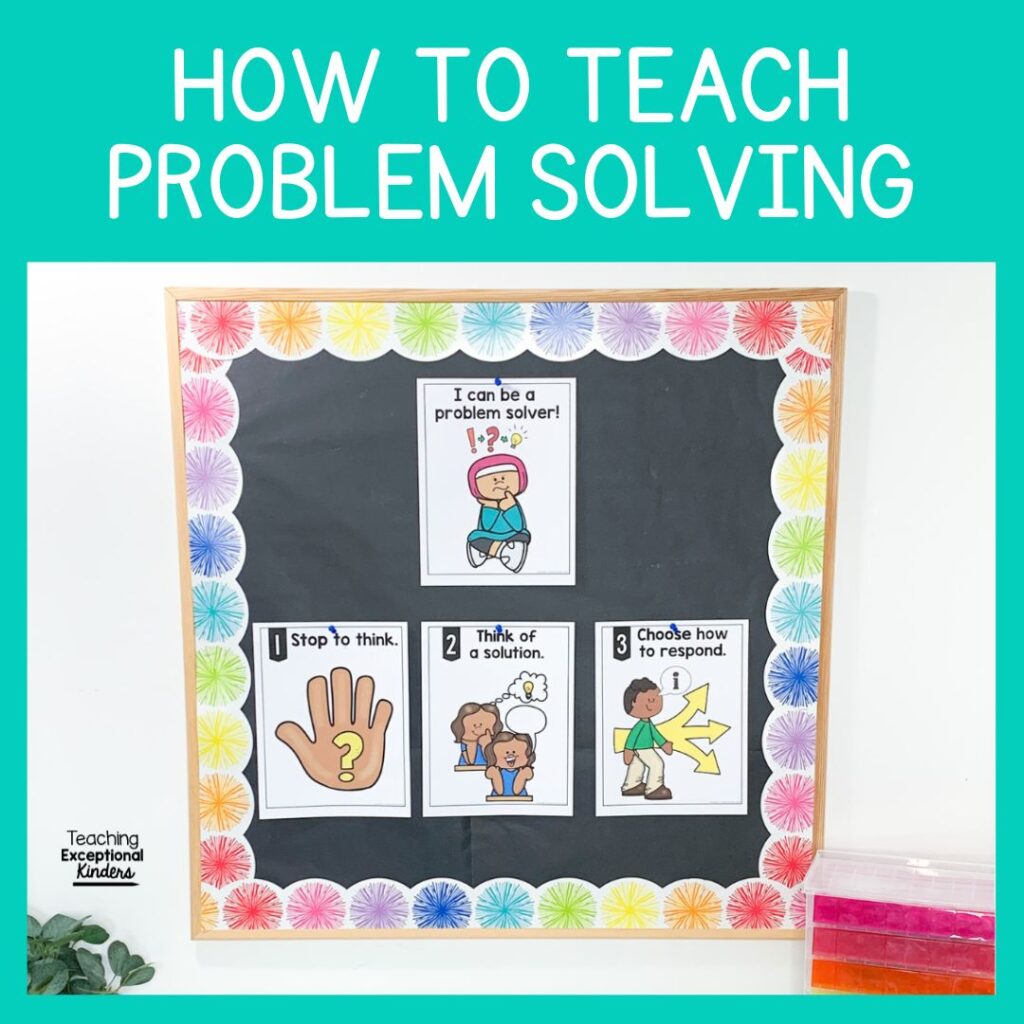
Tips for Teaching Problem Solving in Kindergarten
Learning how to problem solve is an advanced skill that people work on throughout their lives. We definitely shouldn't expect children to be perfect in this skill! However, your students can definitely start to understand that they can solve some of their small problems without adult intervention. Here are a few tips for how to teach problem solving in kindergarten.
1. Focus on Common Kindergarten Problems
When people think of solving problems in kindergarten, they often focus on conflict resolution between students. However, in kindergarten, there can be a wide range of challenges that students experience during the day. For young students, this often means turning to an adult for help.

Procedural – Kindergartners are very routine-oriented. When there is a small bump in the daily routines and procedures, the default is to ask the teacher what to do. These problems could include school supply issues or misplaced items.
Personal – Whether it’s untied shoes or complicated emotions, there are a variety of personal challenges that students experience throughout the school day. These could include personal injury, self-care challenges, and emotional regulation difficulties.
Interpersonal – Kindergarten can be a challenging time for students who are learning to interact with their peers! Students might experience problems related to turn-taking, making shared decisions, and working in groups. These are often the small problems that result in tattling.
2. Identify Your Preferred Solutions
Before teaching problem-solving skills to your students, take some time to identify the solutions that would be preferable in your classroom. For example, when a child finds a lost school supply on the ground, would you prefer that they try to find the correct location for it, put it in your classroom Lost and Found bucket, or set it on your desk?
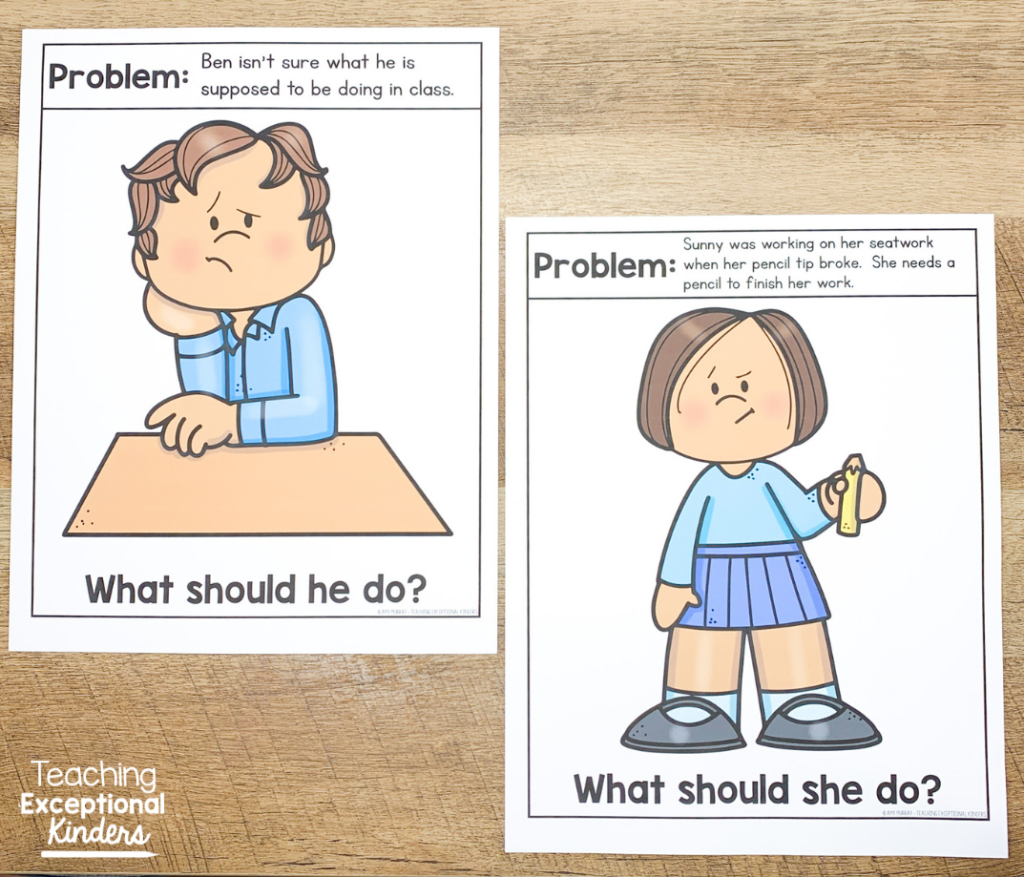
Since many of the challenges kindergartners experience can be procedural, it’s helpful to teach them appropriate solution options that fit within your classroom management system . For interpersonal problems, you might want to identify solutions that fit within your school’s conflict resolution procedures.
3. Teach the Steps of Problem Solving
Once you’ve identified the problems and solutions you’d like to discuss with your students, it’s time for the instruction! Teach your students the three easy steps of solving a problem:
First, they need to stop what they are doing. This helps them focus on the challenge they are facing.
Next, they need to think about the problem and possible solutions. Problems and solutions at school can often be different than those at home or other places.
Finally, they need to choose the best solution for their problem. They should consider how their solutions impact those around them.
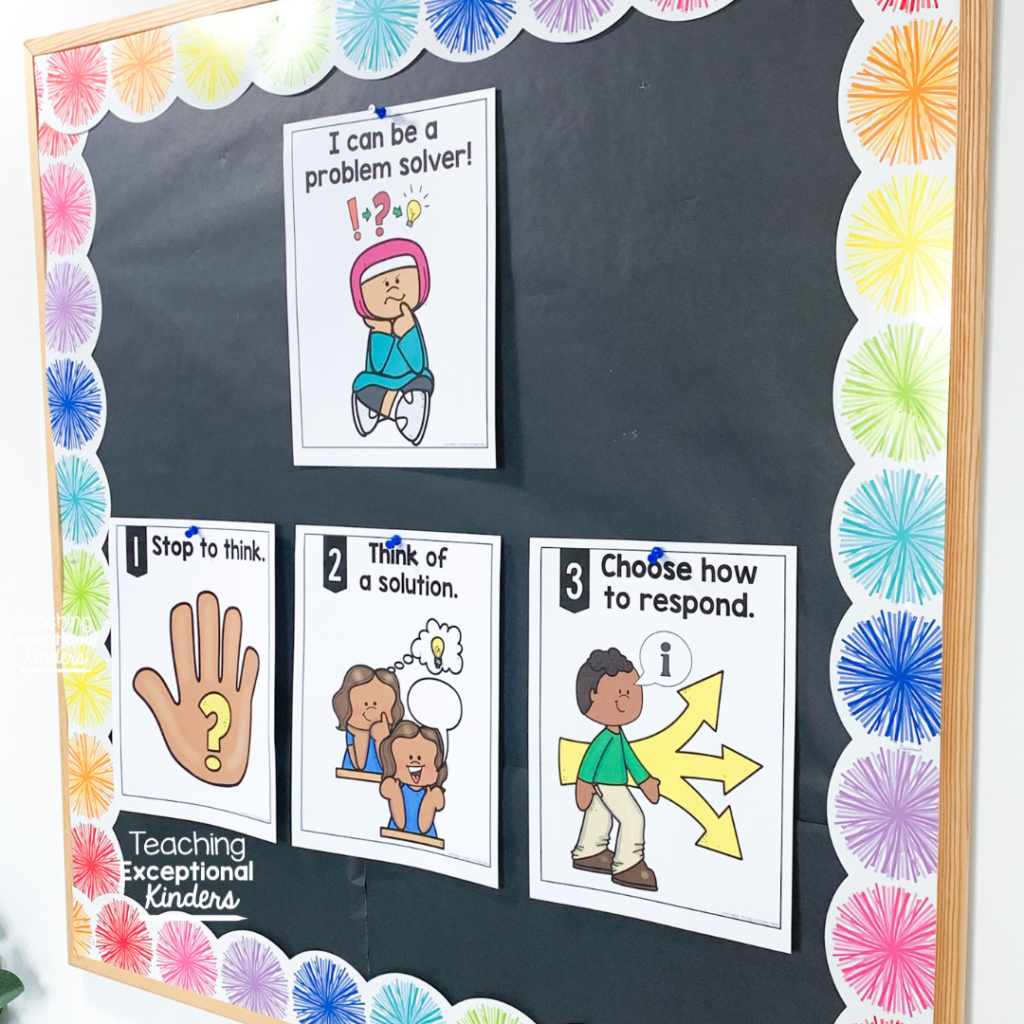
These simple steps are easy for students to remember so they are more likely to use them! It's a good idea to keep these reminders posted as visual support in the classroom so students can reference them throughout the school year.
4. Practice with Real-Life Scenarios
Now that you’ve introduced the steps to problem-solving, it’s time to practice using real-life examples and scenarios! Introduce a common problem that your students might experience in the classroom, on the playground, or even in the lunchroom. Discuss the problem so that all students can understand the challenge that needs to be addressed.
Once your students can identify the problem that needs to be solved, you can discuss possible solutions. It’s helpful for students to learn that there can be different ways to solve a problem. Sometimes students are hesitant to address challenges without adult intervention because they want to know what the “right” thing is to do.
Finally, it’s time for the students to choose the best solution. Students should think about how their solution will impact those around them and find the best option. You can discuss why this particular choice is the best option for the scenario.
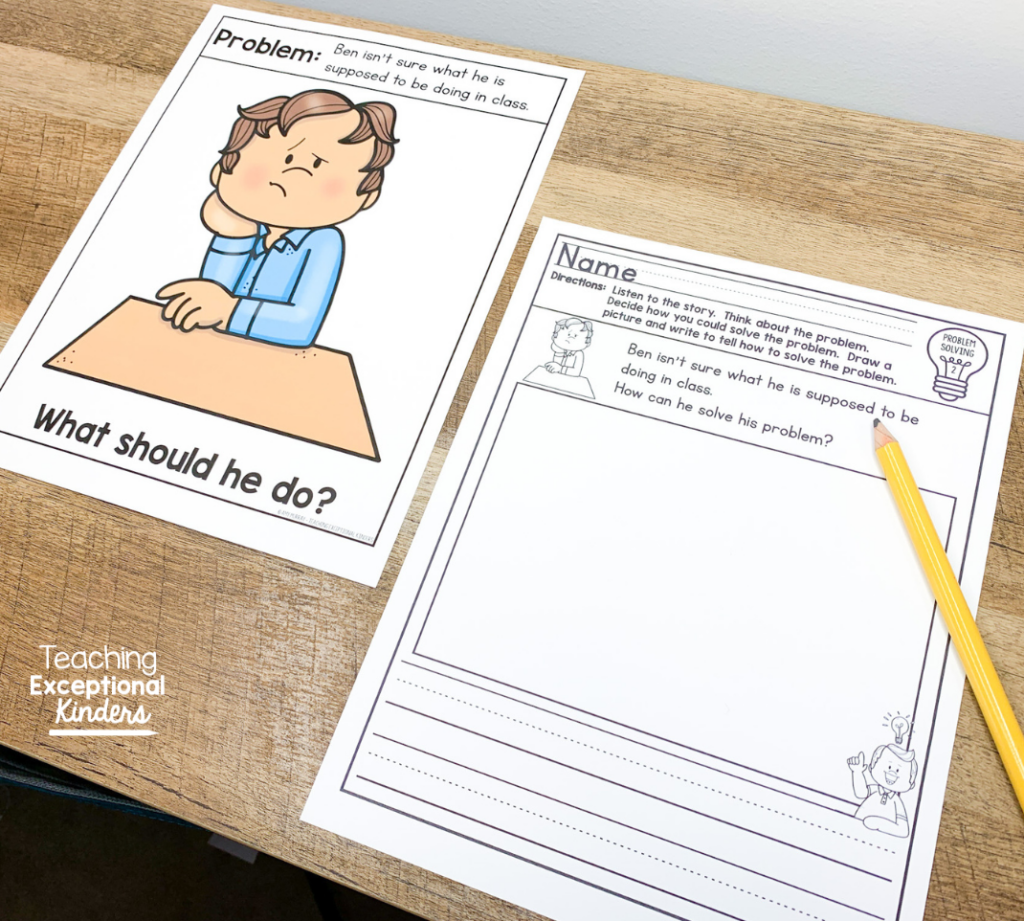
After discussing this real-life scenario together as a class, you can also encourage students to practice independently. Invite your students to complete an independent practice worksheet to show how they would solve the problem.
5. Repeat and Remind
It’s an ongoing process to teach students how to be more independent thinkers and problem solvers. This process of discussing real-life situations will be ongoing in your classroom. Take opportunities to repeat your instruction whenever you can!
Consider modeling for your students when there is a problem that you need to solve as a teacher. This helps them see that you go through the same three steps of problem solving! If a challenge arises that involves the whole class, you might also decide to discuss this together.
If you created an anchor chart during your class discussion of scenarios, you can keep those on display in your classroom. Problem solving posters can serve as a helpful reminder to your students when they find themselves in a challenging situation.
Problem Solving Printables for Kindergarten
Would you like to help your students become more independent in addressing their own challenges? I have created a resource to make it easy to teach problem solving in kindergarten.
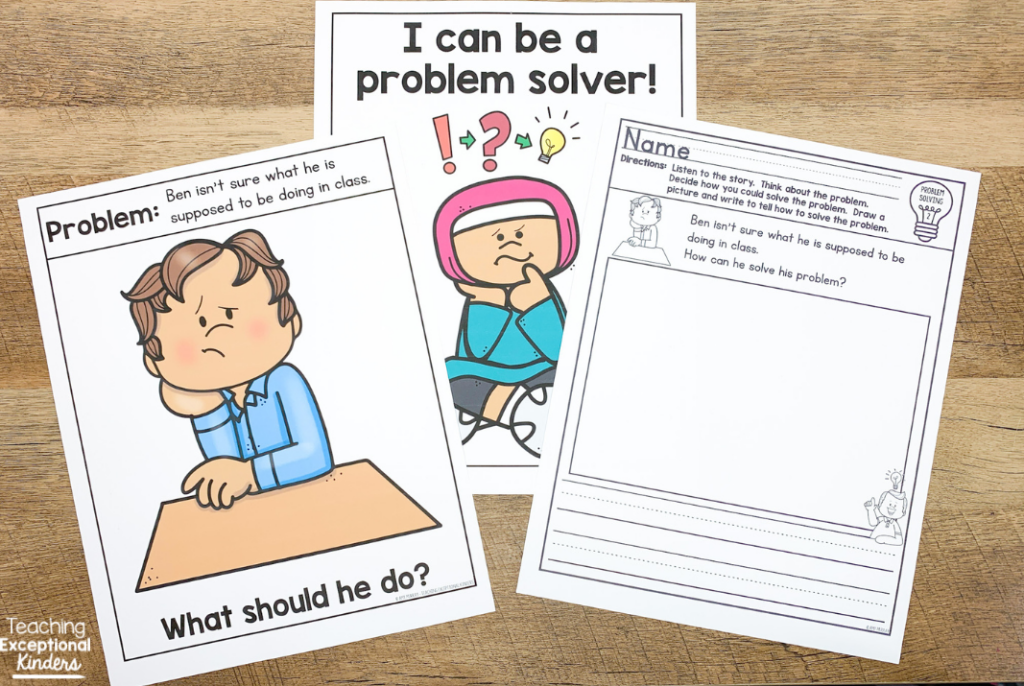
These posters and worksheets will help your students practice problem solving with engaging and relevant scenarios. Every classroom is different and each teacher sets specific classroom expectations. This resource is editable so that you can customize the problem solving scenarios to fit the needs of your classroom.
Would you like to take a closer look at everything included in this resource? You can find it in the Teaching Exceptional Kinders shop or on Teachers Pay Teachers .
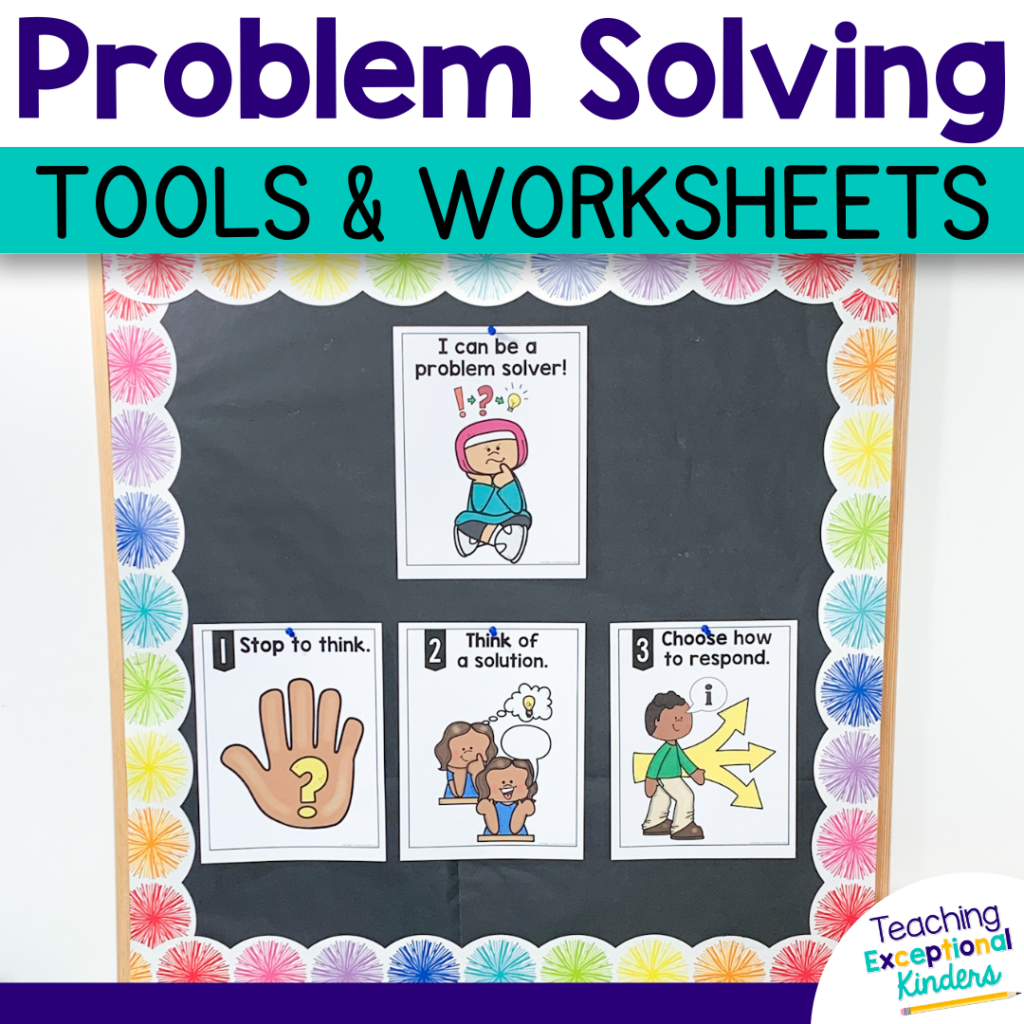
Save These Kindergarten Problem-Solving Ideas
Would you like to come back to this post later? Be sure to add this pin to your favorite teaching board on Pinterest. You’ll be able to quickly find these tips and resources whenever you need them!
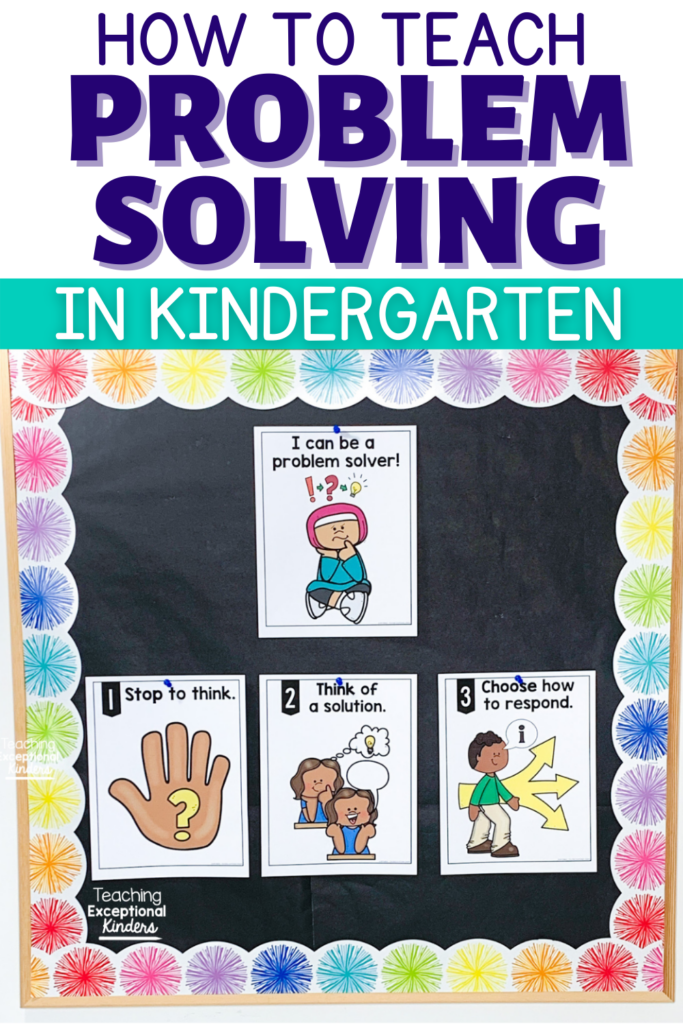
Leave a Reply Cancel reply
Your email address will not be published. Required fields are marked *
Save my name, email, and website in this browser for the next time I comment.
QUICK LINKS
Join over 120,000 educators for tips & tricks in the Facebook group .
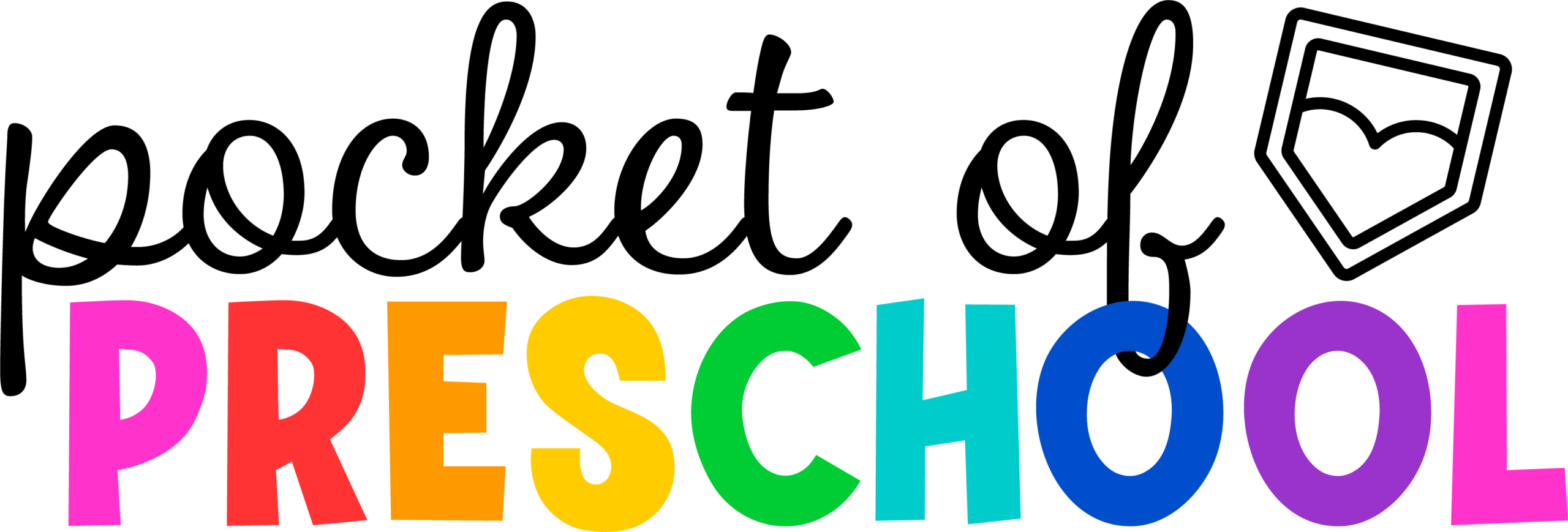
- Back to School
Teaching Tips
Social emotional, problem solving with little learners (preschool, pre-k, and kindergarten), share this post:.
- Share on Twitter Share on Twitter
- Share on Facebook Share on Facebook
- Share on Pinterest Share on Pinterest
- Share via Email Share via Email
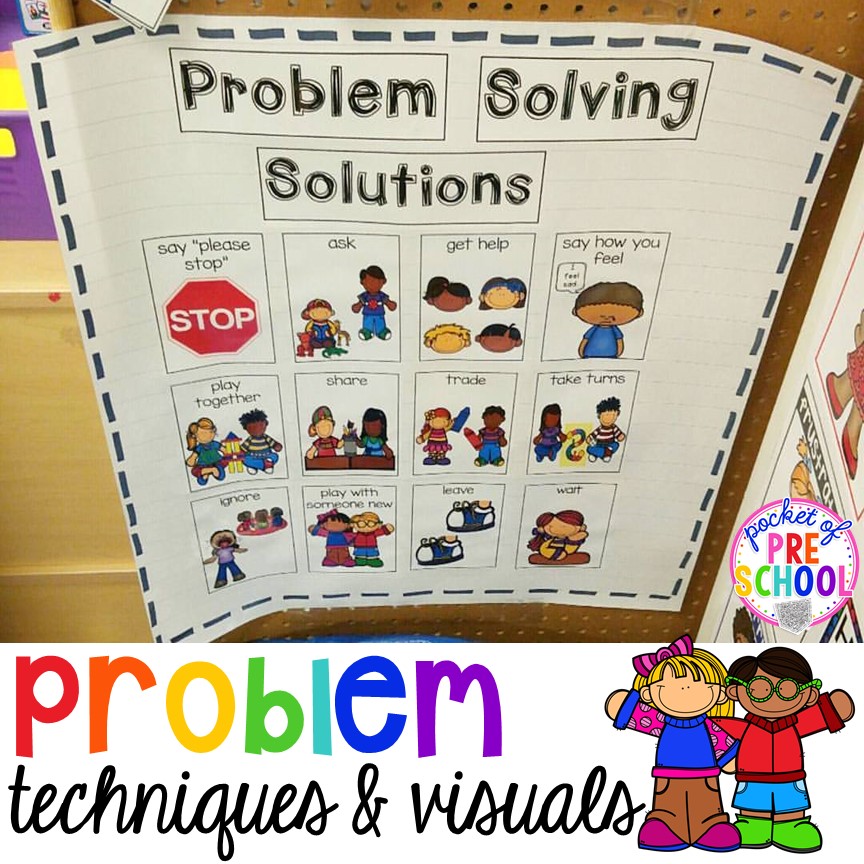
Problem solving is challenging for young students (and many adults too)! To support my little friends, I teach them problem solving strategies that they can use when they encounter a problem. We want our students to become independent thinkers who can solve problems, control their emotions, express empathy, and help others.
I introduce the problem solving techniques a few at a time during a class meeting. Each week, I introduce three new problem solving techniques. We then end up with nine to twelve techniques total based on what my students need that year. I explain the technique to the students in concrete terms so they will understand what the technique is and what it can look/sound like.
We usually start with these four skills: “please stop”, ask, get help, and say how you feel. Many problems can be solved with those solutions, which is why I always start with those. Then, the following week, I introduce take turns, play together, trade, and share. Then, the last four solutions the next week.
Problem Solving Techniques
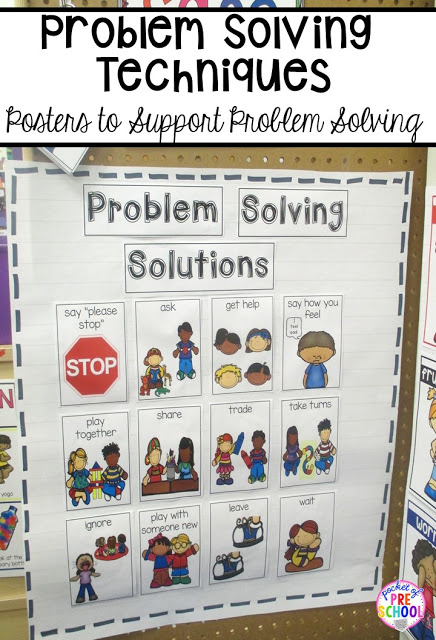
Singing with puppets is a fun and active way to practice the problem-solving techniques . Preschoolers LOVE puppets! This technique also allows students to role play. Some students will be more verbal if they can pretend to be someone else. At the end of each verse, students act out the problem-solving technique with a buddy using the puppets!As a transition activity to lunch, students took turns sharing a way they have solved a problem. You can also play, “What would you do if….”. State a real problem that could happen and have students pick a problem-solving solution to solve the problem. Some examples would be, “What would you do if your friend took your book?”, “What would you do if you got sticky glue on your hands?”, or “What would you do if you needed the red marker and your friend was coloring with it?” Once they have learned the strategies, stand back and let students try solving their own problems independently. Just a warning: this can take some time with lots of practice and support. As long as the student isn’t frustrated, let them try before you jump in to help. You will be amazed at the problems your child can solve given the opportunity to.
At first, you will be giving students lots of support and giving them the words to use to solve a problem.
- Always approach students at their level, in a calm supporting way.
- Ask, “what’s the problem?” If they don’t respond, comment on what you see such as “I see you have glue all over your hands and it looks sticky.”
- Restate the problem. “So the problem is ….”
- Brainstorm solutions and choose one together. This is the perfect time to use problem solving card visuals! “How can we solve this problem?” Flip through the solution cards and ask “Could we ….?”
- Praise and observe! Cheer on the students for solving the problem and stay close just in case they need more support.
Throughout the day, try to make EVERYTHING a problem to solve. Then model, talk through your thinking out loud, and use visuals to support students as they try to solve a problem. For example, I may put out a big ball of playdough in the center of the table as a small group activity. Students have to problem solve so each student has play dough to play with. It only takes few extra minutes to sneak in problem-solving situations throughout the day. Each time students help solve a problem or observe a friend solve a problem, they learn to self-regulate, express emotions appropriately, develop empathy, and develop problem-solving skills.
State problems for students who look stuck. If a student is just standing there, they need support, but don’t solve the problem for them! It’s so easy to do. Simply state their problem or what you see and ask a probing question. For example, if a student is standing with an empty bowl in their hand, you could say “Your snack spilled on the floor. How can you solve the problem?”
Problem-Solving Necklace or Mini Book!
I hole punched the small cards, put them on a book ring and keep them on a lanyard I wear every day. This way I can support students’ solving problems without having to go to the safe place where they are posted. I can just show the picture cards as a visual on my necklace. The mini book in the safe place works the same way.
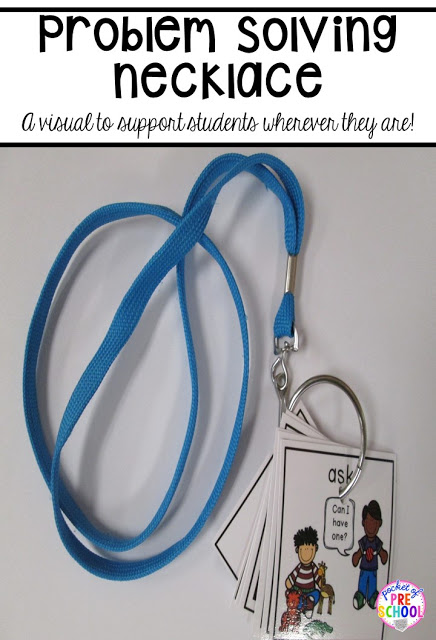
Safe Place!
I keep my techniques posted in my circle area at the beginning of the year AND in my safe place. My safe place is a small spot in my classroom where students can go when they are upset, need to calm down, want to be alone, or have a problem.
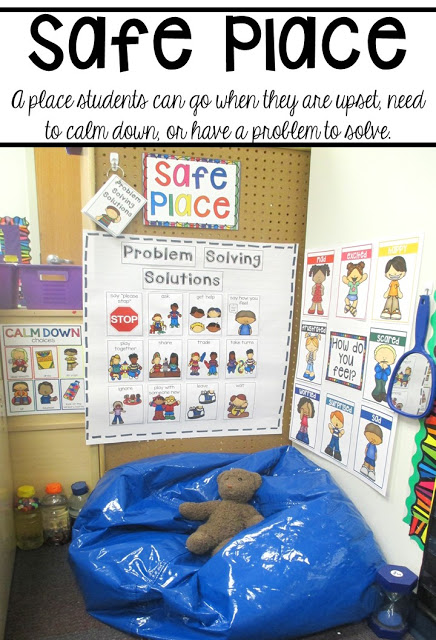
Once I see students using the problem-solving techniques independently, I remove them from my circle area. They are posted in my safe place ALL YEAR LONG for students to use when they are struggling to solve a problem. In my safe place, you will find a mirror, feeling chart, bean bag, sensory bottles, calm down choices, a stuffed animal, problem solving mini book and problem-solving techniques chart. You can read all about how to set up a safe place in your classroom HERE . Children’s Books!
These are some of my FAVORITE children’s books to teach all about problem-solving. As we read the book, we talk about how the character is or isn’t solving the problem, how it makes the character and others feel, any natural consequences that could occur, and which one of our problem-solving strategies the character could use to solve the problem.
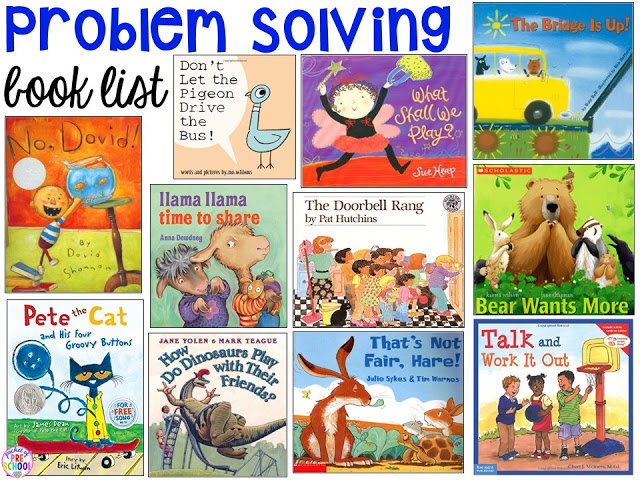
Do you want to use them in your classroom? You can! I did the work for you. Grab them from my TPT store HERE .
LOVE it? Pin this image!
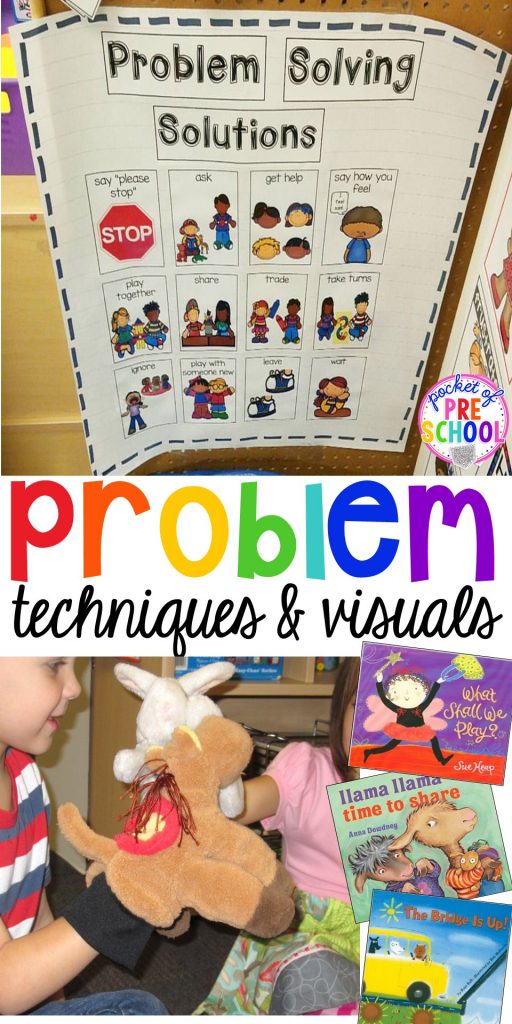
hey, i’m jackie!
I’m Jackie, your go-to girl for early childhood inspiration and research-based curriculum.
Similar Posts
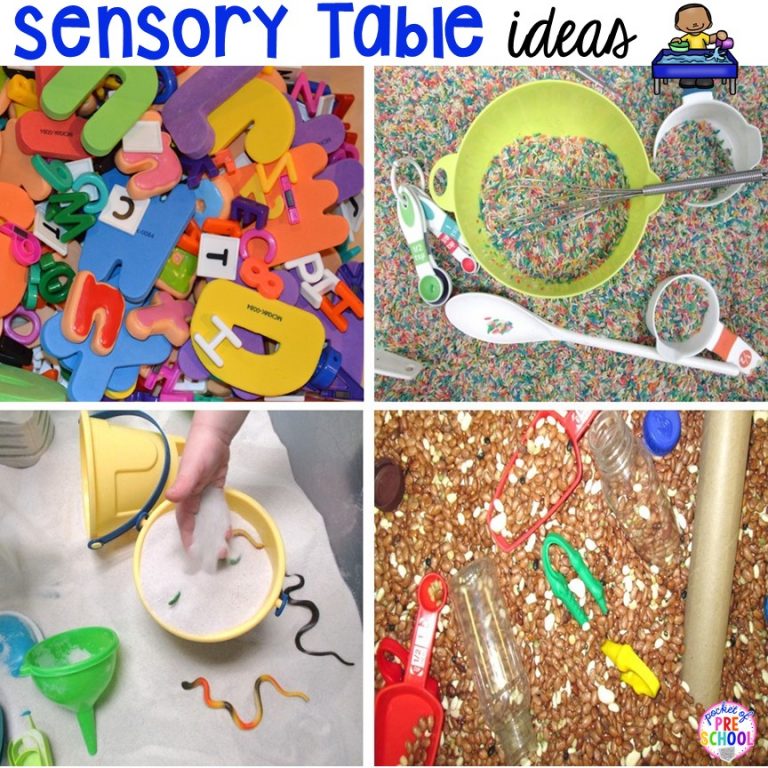
Sensory Table Fillers, Tools, Hacks, & Printable Planning Lists
The sensory table is a staple in any Early Childhood classroom (or it should be). Each week, I methodically create a plan for the sensory table. It is a place…
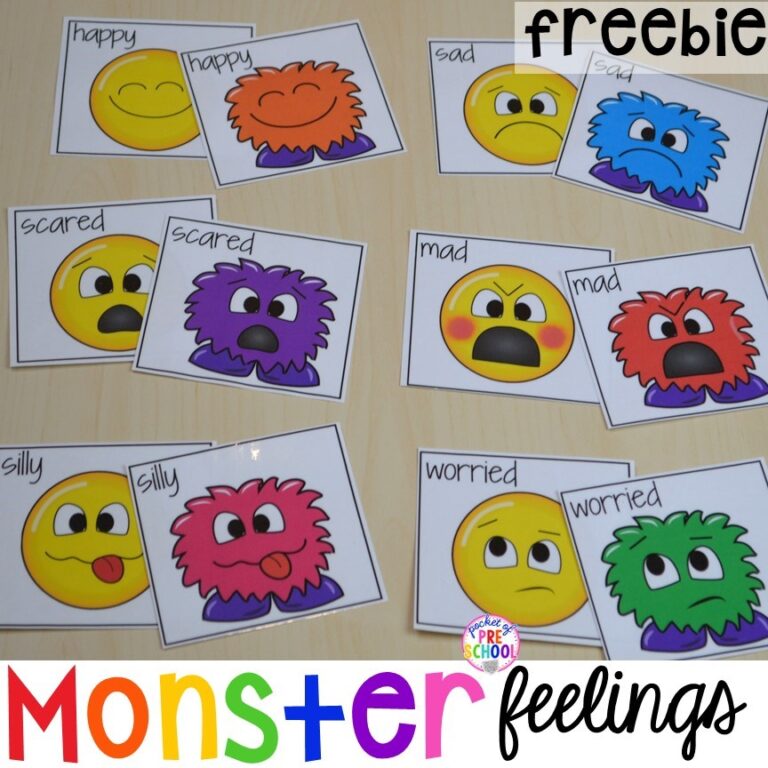
Monster Feelings Match Up
Teaching students about feelings, aka emotional literacy, is SO IMPORTANT for little learners. Identifying and labeling feelings in oneself and others is a life skill that takes lots and lots…
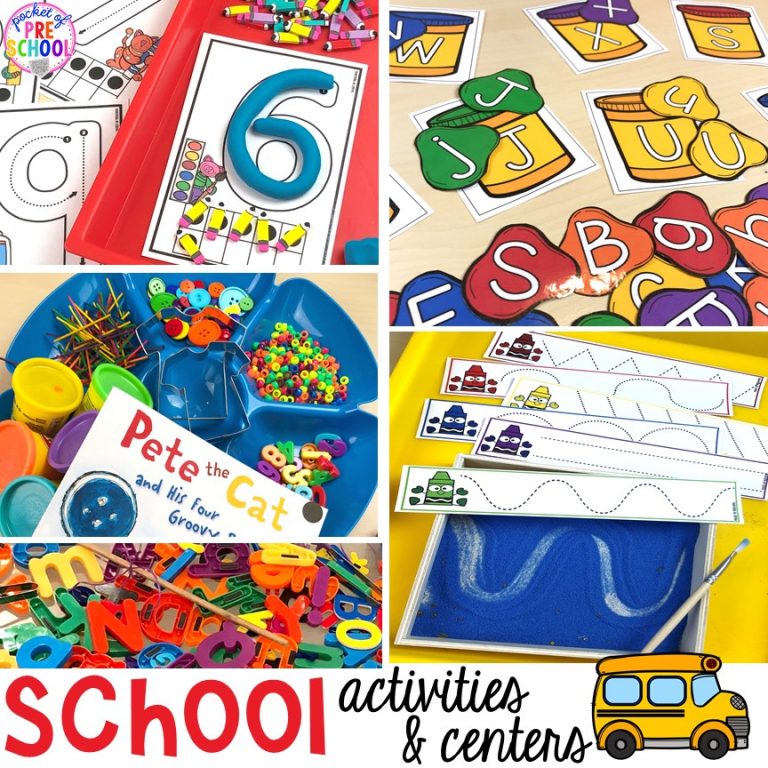
School Activities and Centers for preschool & prek
It’s back-to-school time, which means it’s time for school activities and centers to help your preschool, pre-k, and kindergarten students get to know the classroom and supplies. Learning what tools and…
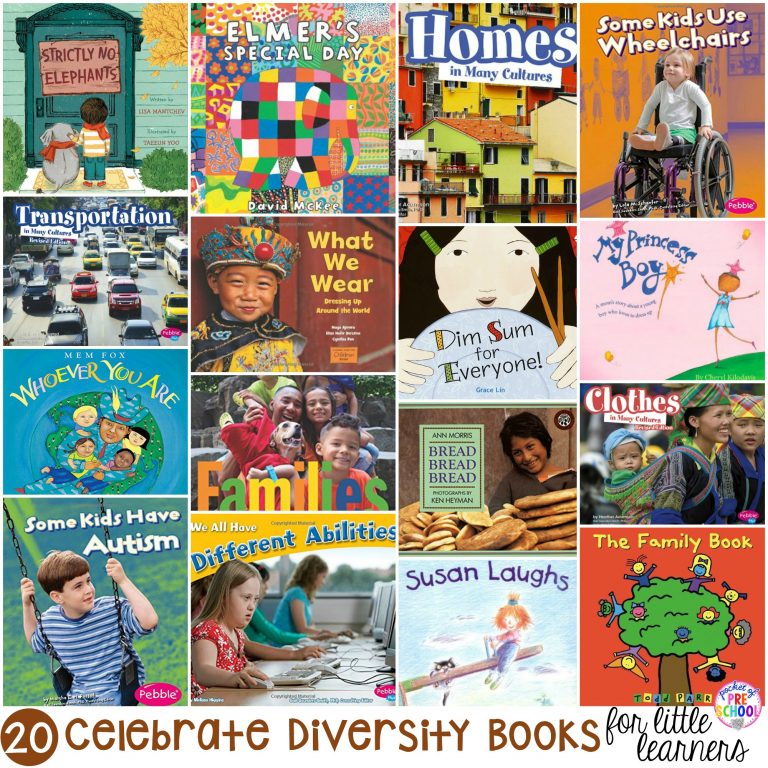
20 Celebrate Diversity Books for Little Learners
Celebrate differences with tons of diversity books for little learners! Titles about family makeup, different cultures, & acceptance of others. In my classroom, we celebrate diversity with books! Every child…
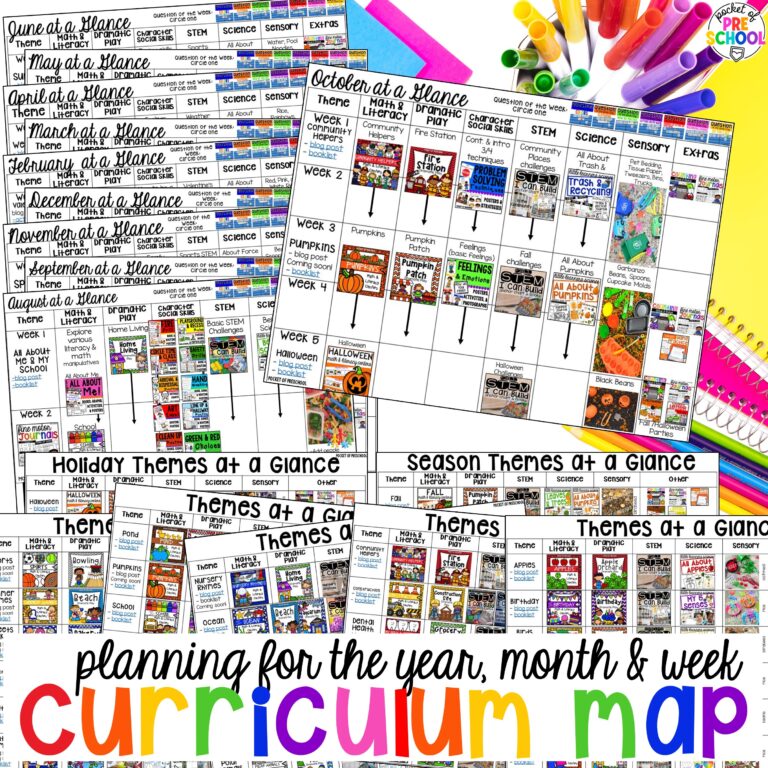
Curriculum Map for Preschool, Pre-k, and Kindergarten
Planning for the entire year can be overwhelming and stressful! I’m here to help. I’ve created a year-long Curriculum Map for preschool, pre-k, and kindergarten. You will find a Year-at-a-Glance,…

Printing Help and Support for Teachers Printing PDF Documents
Technology can be tricky and super frustrating, especially when it comes to printing. Honestly, sometimes makes me want to throw my printer out the window! But I’m here to give…
Follow On Instagram
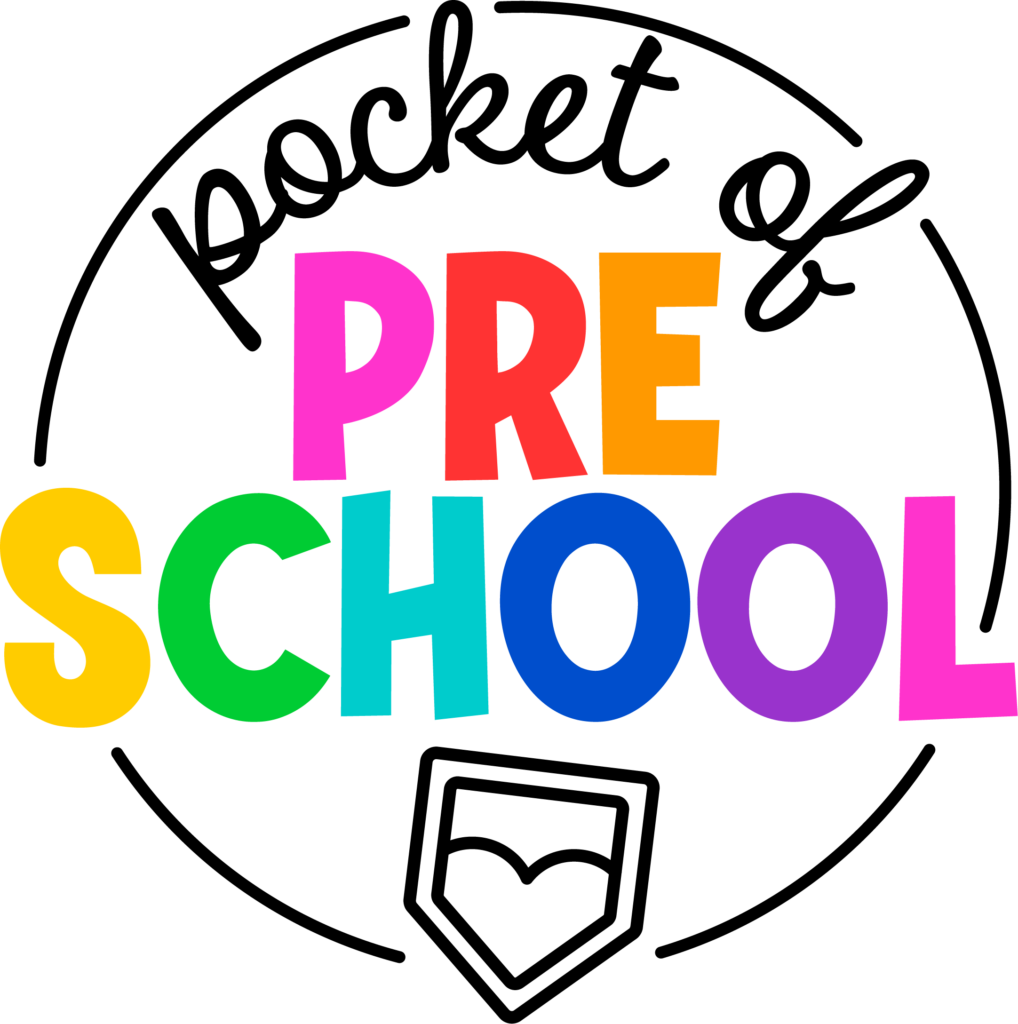
©2023 Pocket of Preschool. All Rights Reserved. Designed by Ashley Hughes
Review Cart
No products in the cart.
Dramatic Play
Special July offer - 7 days free unlimited access to all premium content Try Premium
- Interactive
- Kindergarten
Word Problems
Kindergarten word problems interactive.

Filter by Grade:
Filter by subject:.
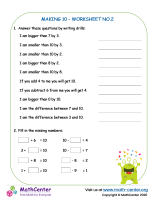
Kindergarten Lessons
Involve me and I learn...
KINDERGARTEN MATH PROBLEM SOLVING
Organize your routines to promote plenty of kindergarten math problem solving.
It’ll help children make sense of math concepts as they solve problems using real life objects and everyday situations that they can relate to.
When children learn to recognize a problem, try a few problem solving strategies, suggest a variety of solutions to solve the problem, and finally, test their ideas. They will gain confidence and have a chance to use skills that they have learned previously.
Keep Math Problem Solving Activities Simple
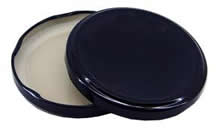
- Jars from pasta sauce and other products work well also.
- Ask parents to save clean jar lids that are large enough to hold 3 one-inch blocks. Check there are no sharp edges.
- Cups are too deep for the following activities as the children cannot easily see how many counters they have put into each cup.
Literature based problem solving games
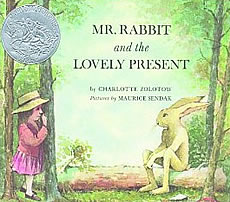
Game – Birthday party across the river
Set up the problem by reading a book such as Mr. Rabbit and the Lovely Present.
After reading it, talk about:
- What was the little girl’s problem?
- What did she do to solve it?
- How did Mr. Rabbit help?
- How did they solve the problem?
Boats and River Game
- Boats – One jar lid per child (such as the ones that pasta sauce comes in) that hold 3 one-inch Unifix™ cubes. The lids represent the boats.
- Presents – Ten one-inch Unifix™ cubes for each student. These represent the presents. Vary the number of blocks, depending on the children’s abilities.
- 1/2 sheet of blue construction paper cut lengthwise – this is the river
- Recording sheet and pencils
- Introduce the problem – Tell your students that you are pretending that all ten of Mr. Rabbit’s presents (cubes) have to get across the river for a birthday party. The presents will have to go in the boats (jar lids) but can not be stacked on top of each other or they will fall in the water. Only 3 presents can fit into a boat but all the presents have to get to the party.
- How many trips across the river does your boat need to take?
- Each child loads their boat with 3 cubes and take them across the river then unloads their boat
- Children record each trip with a tally line.
- Vary the number of blocks with each game
Sharing type problem solving
- Counters, blocks or crackers
- Small paper plates – 4 per child
- Lids and blocks as above
Focus on different ways of solving the problems. Vary the games and materials each time:
- Game #1 – Say to the children – “You have 4 plates, one for each friend, and 12 crackers. How can you make sure that all your friends get the same number of crackers?”
- Game #2 – Each child gets 4 lids and 12 blocks. “How you can put the blocks into the lids so all the lids have the same number of blocks?”
- Game #3 – Each child gets 2 plates. Goldfish type crackers are in bowls near the children. “How can we figure out how many crackers we will need if each plate has 10 crackers?”
Seating & PE equipment type kindergarten problem solving
One group of children watches while the other group acts out the problem.
Prompt with suggestions as necessary. E.G. How could we figure that out? All the children can contribute ideas to solve these types of problems.
#1 – Four children can sit around each table. We have 12 children. How can we figure out how many tables we need so everybody can sit down?
#2 – We have 6 balls and 12 children. How can we share the balls so all the children get to play with the same number of balls?
#3 – This group has 4 children. If each child jumps 3 times, how can we keep track of how many jumps will they jump all together?
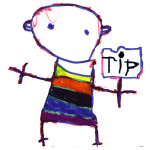
Tip – Save these types of problems for after the children have had plenty of activity and are ready to sit and rest for a while.
Spatial type problem solving
- Pattern blocks
Ask questions such as the ones below.
1. How many ways can you make a bird (or flower or star…) using only 5 pattern blocks? Children spend 5 minutes making birds. Have them count the number of pattern blocks in each bird as they sometimes get carried away and end up making a bird with many more blocks!
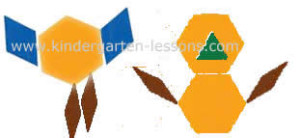
2. Show me how you can make 3 different stars can with your pattern blocks?
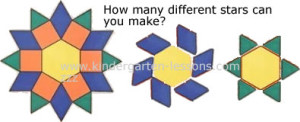
Recording problem solving activities
Prompt students to record the results of most activities, even if they are only able to make a simple picture.
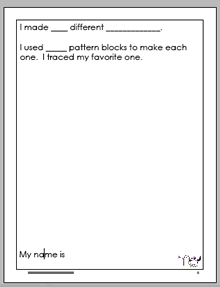
Many opportunities for math problem solving will arise in a regular preschool or kindergarten day.
- Keep problem solving simple and age appropriate
- Focus on problems that have open-ended results
- If children get frustrated, give them the option of leaving the problem and coming back to it later
Kindergarten Logic and Problem Solving Worksheets
- Most Popular
- Most Recent
| Add to Folder | |
|---|---|
| creative writing | |
| children's book | |
| activities | |
| classroom tools | |
| language arts and writing | |
| vocabulary |

- Grades 6-12
- School Leaders
Get our FREE 'Meet the Teacher' bundle!
25 Kindergarten STEM Challenges That Little Ones Will Love
They’re never too young to create and explore!
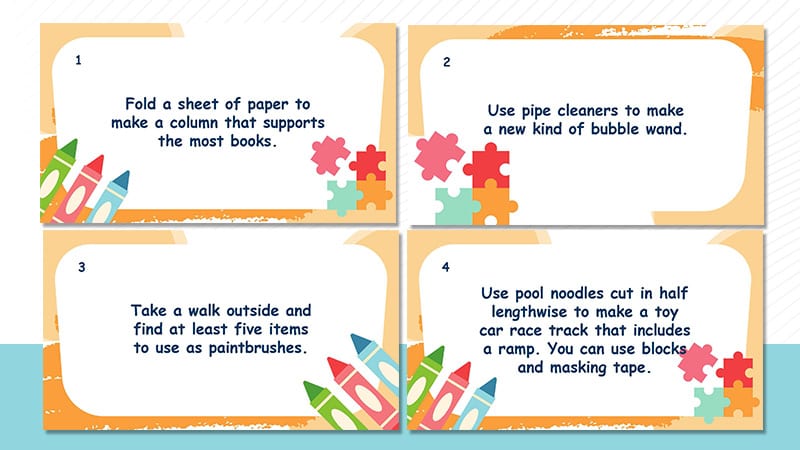
STEM challenges are such a fun way for kids to explore how the world works. By building and creating, they learn problem-solving skills and get hands-on experience with physics, engineering, and more. These kindergarten STEM challenges prove that even little ones have plenty of ingenuity and inspiration.
The best part? These challenges are so easy to set up. They require only basic supplies, like wood craft sticks, pipe cleaners, or blocks. Just post one of these kindergarten STEM challenges on your whiteboard, explain the requirements, pass out the supplies, and watch young minds grow!
Want this entire set of STEM challenges in one easy document? Get your free PowerPoint or Google Slides bundle of these first grade STEM challenges by submitting your email here, so you’ll always have the challenges available.
Just a heads up, WeAreTeachers may collect a share of sales from the links on this page. We only recommend items our team loves!
25 Kindergarten STEM Challenges
Fold a sheet of paper to make a column that supports the most books..
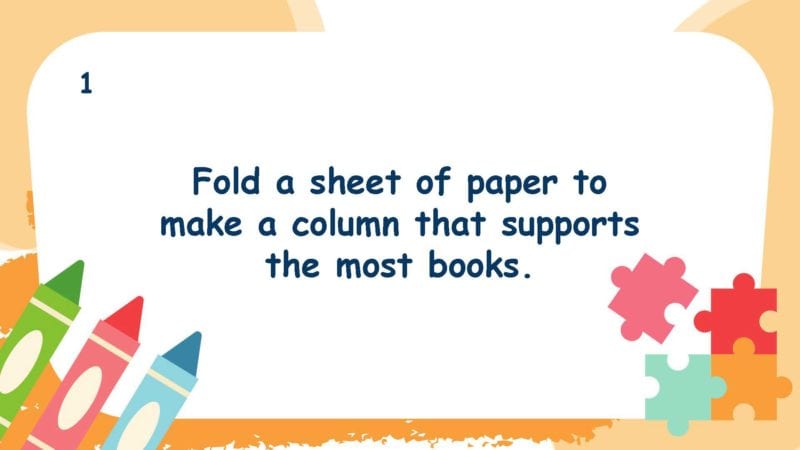
Use pipe cleaners to make a new kind of bubble wand.
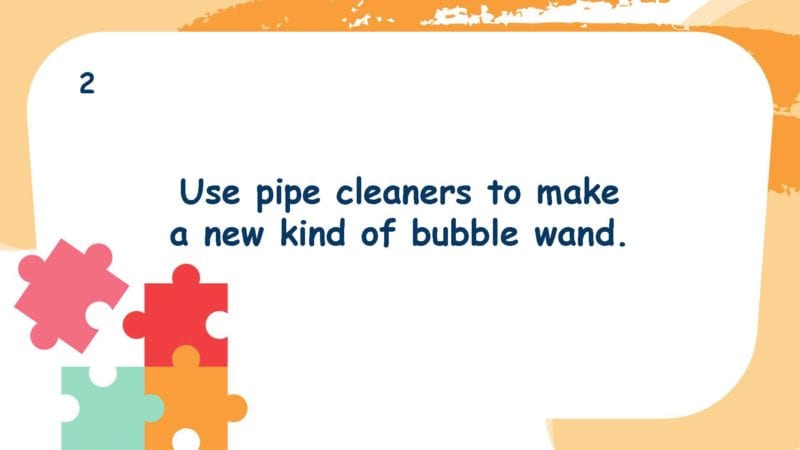
- Zees 1000 Pipe Cleaners in Assorted Colors
Take a walk outside and find at least five items to use as paintbrushes.
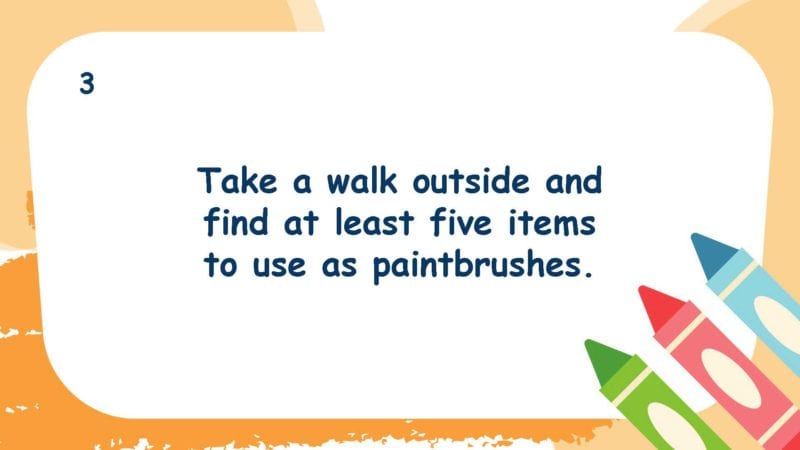
Use pool noodles cut in half lengthwise to make a toy car race track that includes a ramp. You can also use blocks and masking tape.
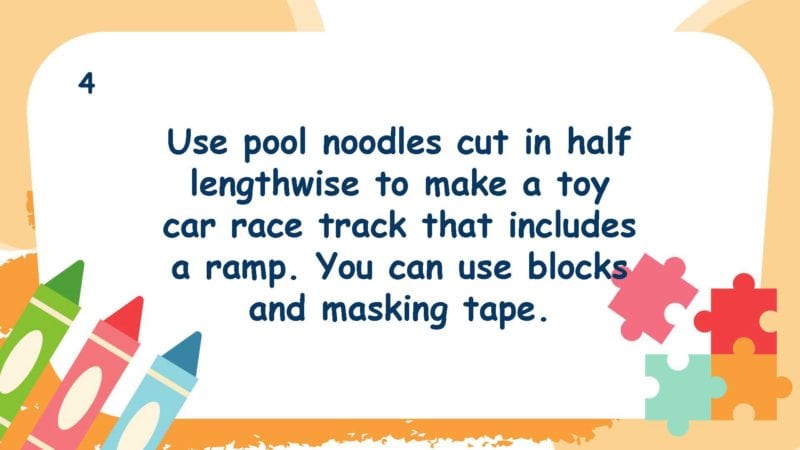
Build the tallest tower you can using wood craft sticks and clothespins.
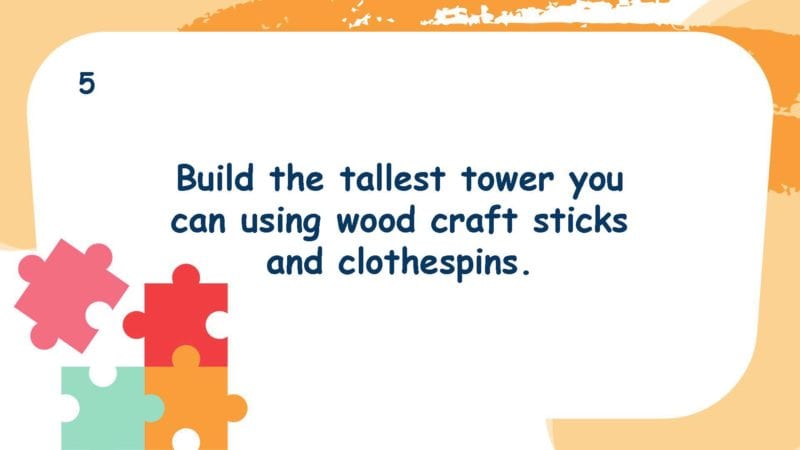
- Whitmore 100 Natural Wood Clothespins
- Pepperell 1000 Natural Wood Craft Sticks
Mix red, blue, and yellow finger paints to make as many new colors as you can.
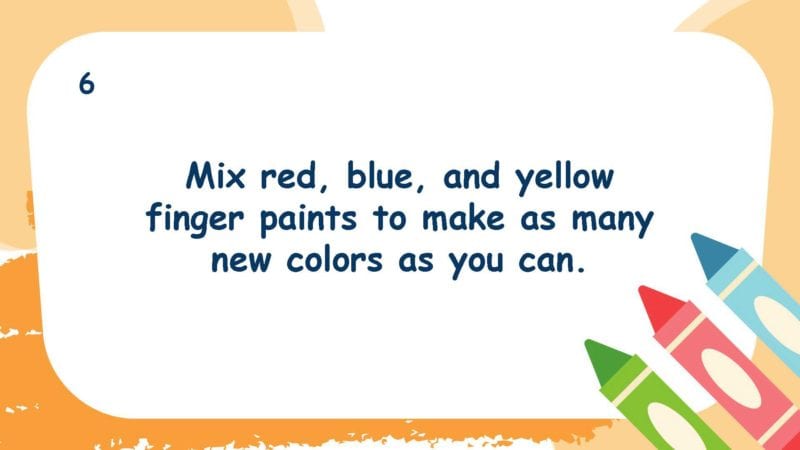
Use toothpicks and marshmallows to make as many different shapes as possible.
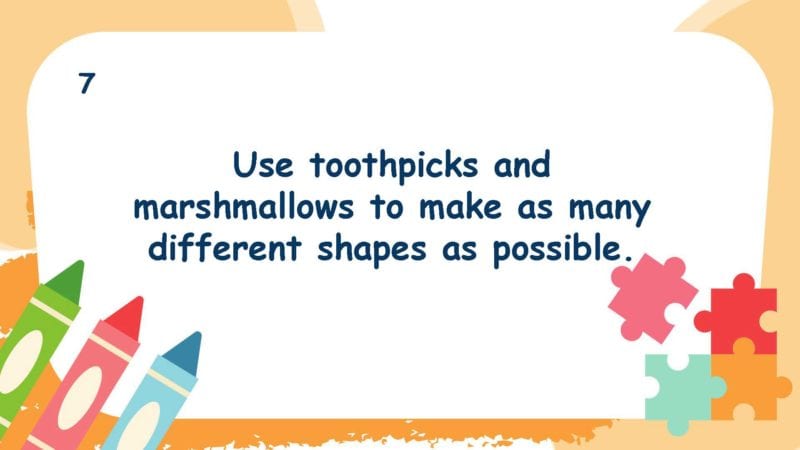
- 1000 Count Natural Bamboo Toothpicks
Use one can of shaving cream to build the tallest structure you can.
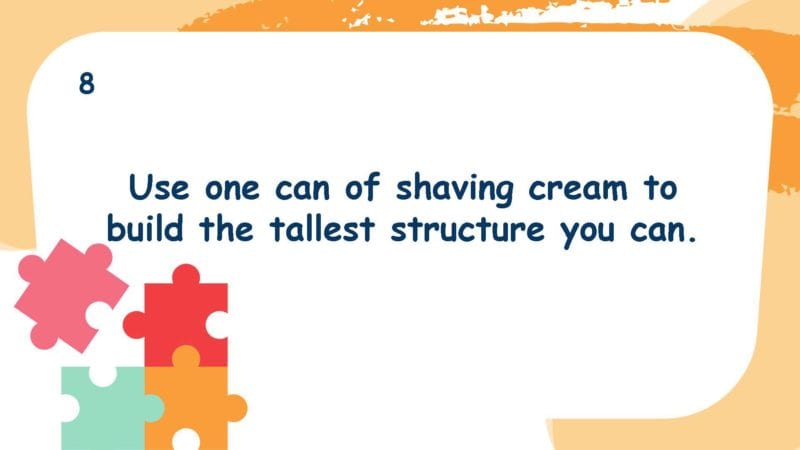
Stack 15 plastic cups into the tallest tower possible.
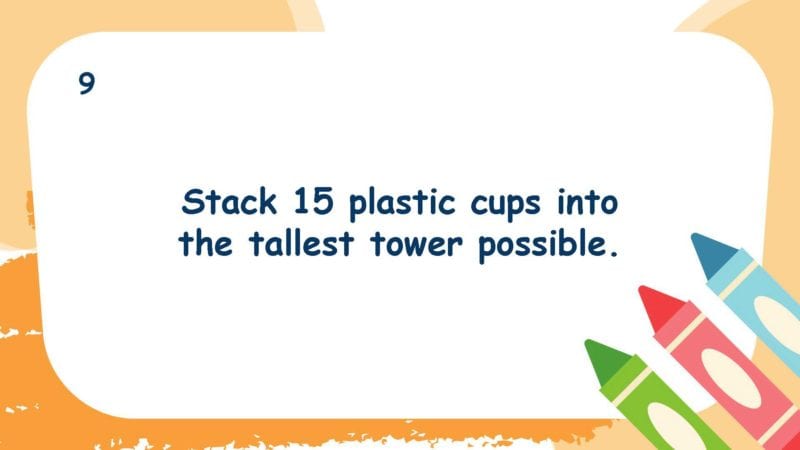
- Clear Disposable Plastic Cups, 500 Pack
Gather twigs outside and use them to build a house for one of the Three Little Pigs.
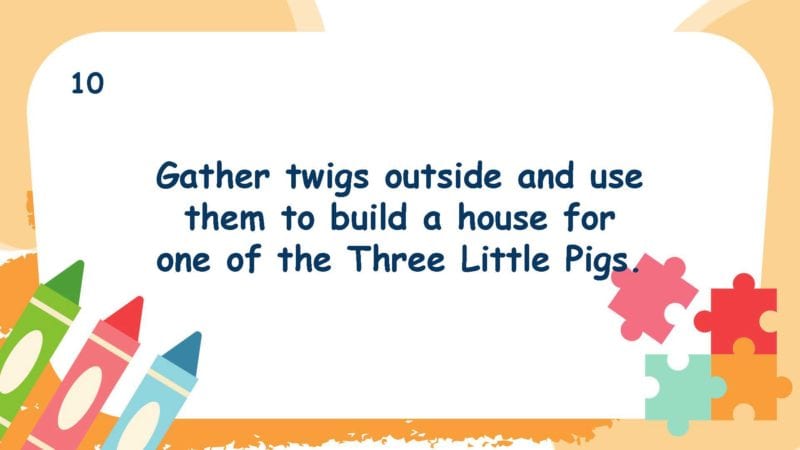
Use 5 pipe cleaners to make the longest chain you can. The chain must be able to hold a small cup of jellybeans.
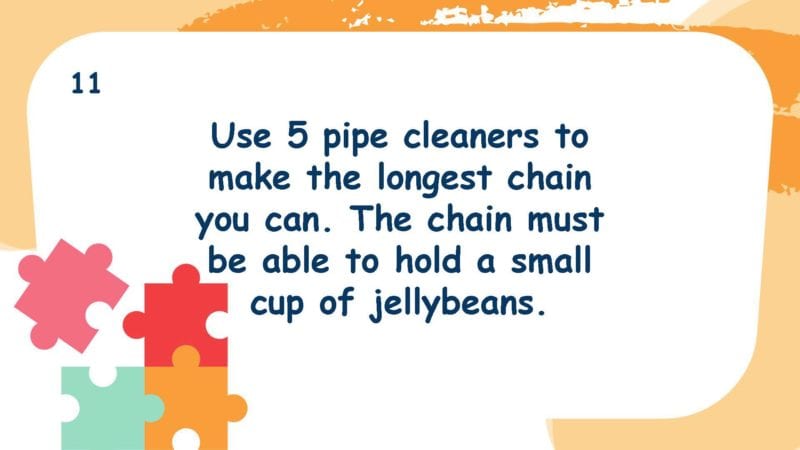
Build the tallest tower possible using buttons and Play-Doh.
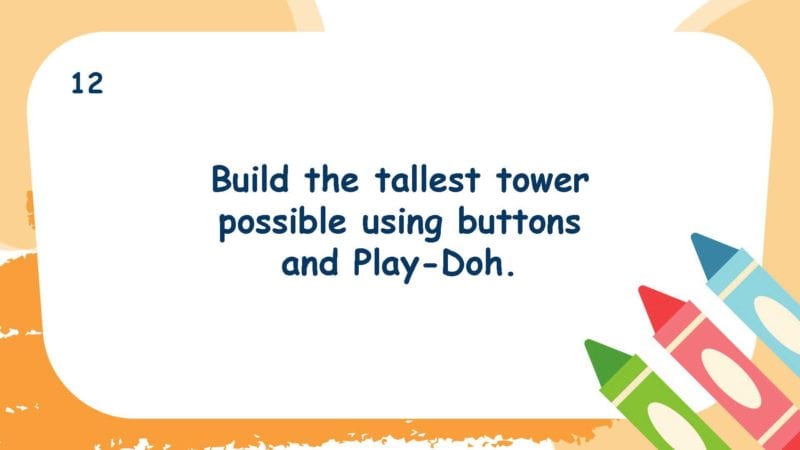
Use a cardboard box, wood craft sticks, construction paper, and supplies like scissors and glue to build a monster trap.
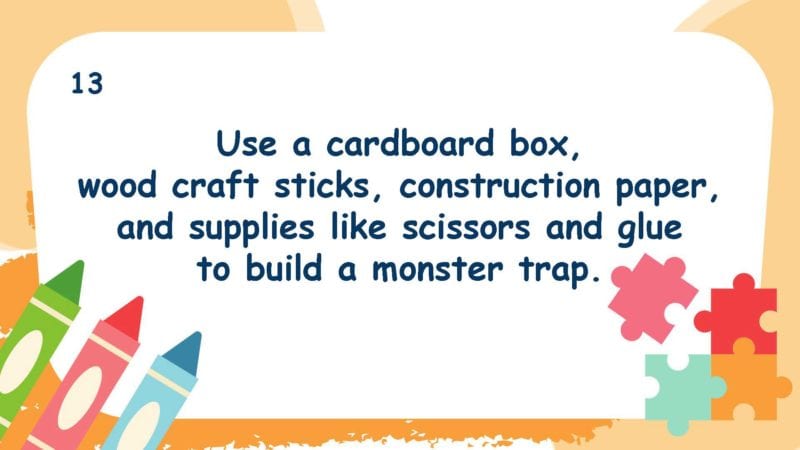
Make a domino chain reaction that includes two curves.
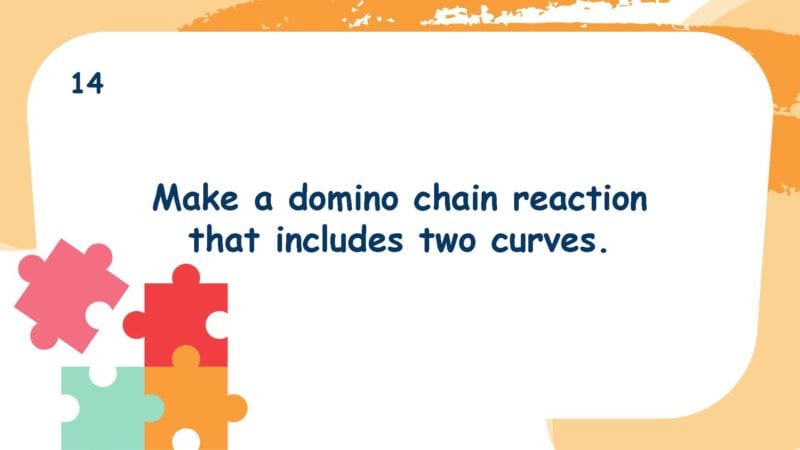
- Lewo 1000 Pcs Wood Dominoes Set
Use newspapers and masking tape to make a tent for a stuffed animal.
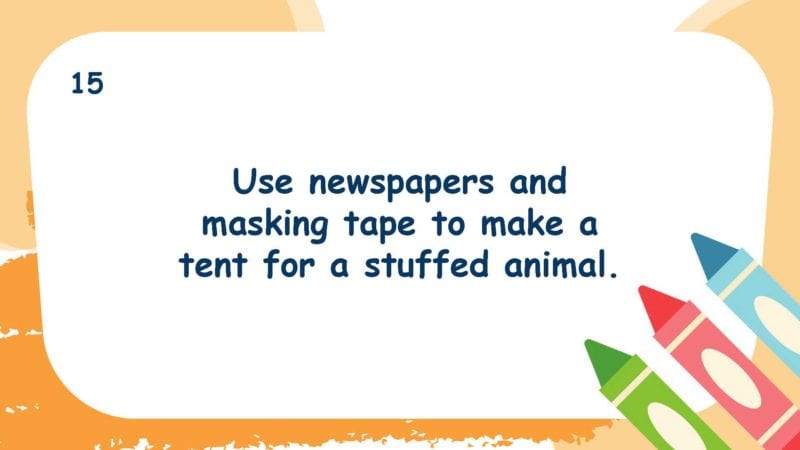
Build a bridge that can hold 100 pennies using wood craft sticks and toilet paper tubes.
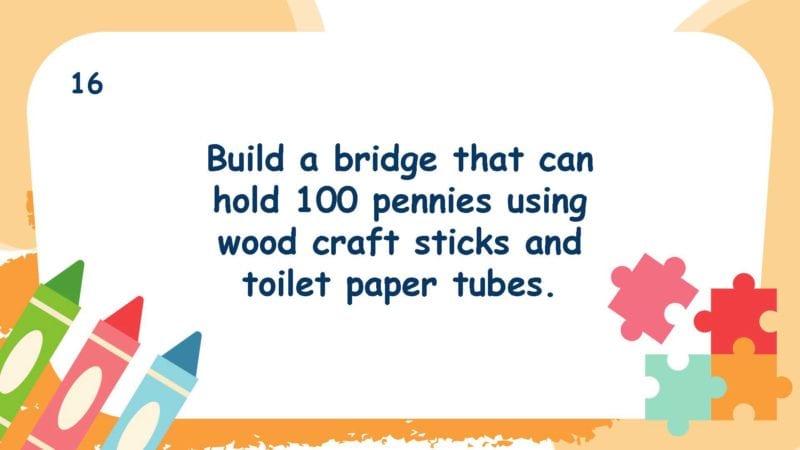
Scoop up one cup of random LEGO bricks and use it to make a new kind of animal.
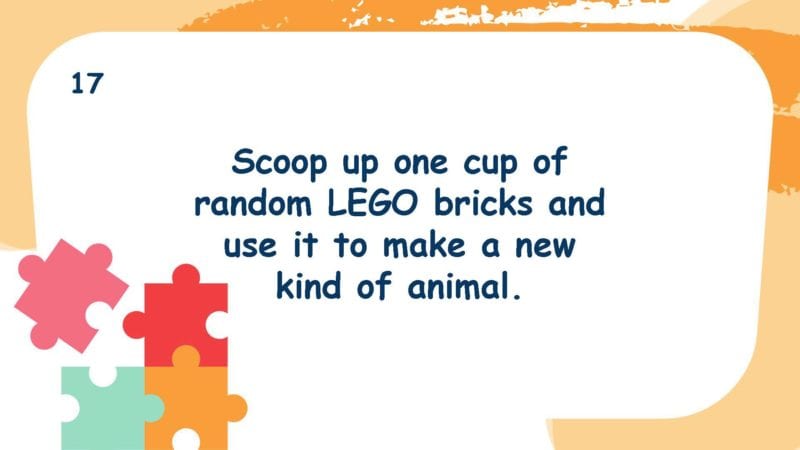
Use plastic straws and masking tape to build the tallest possible tower.
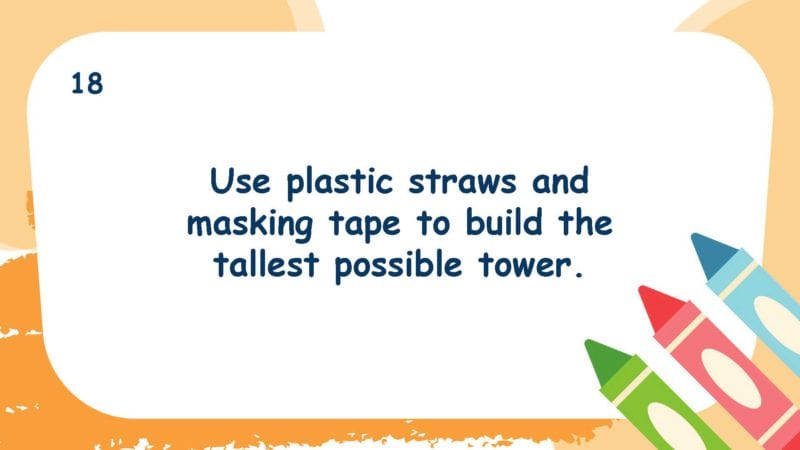
- TOMNK 500 Multicolored Plastic Drinking Straws
- Lichamp 10-Pack of Masking Tape 55 Yard Rolls
Design a repeating pattern necklace from Cheerios and colored beads.
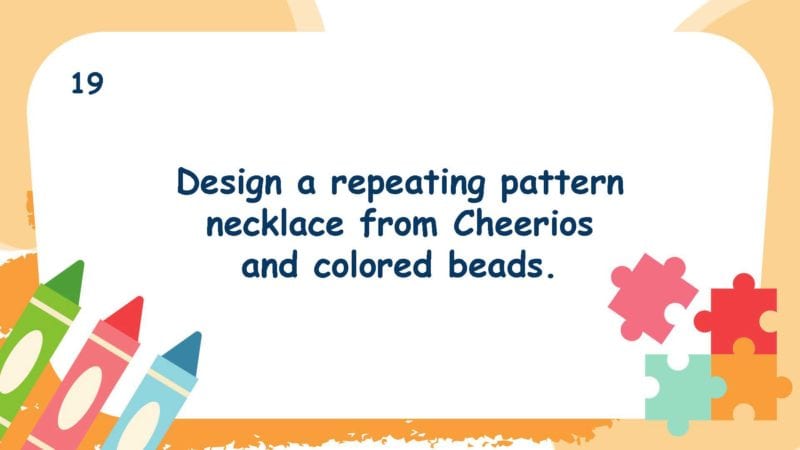
Find three different things to fill plastic eggs to make them sink to the bottom of a tub of water.
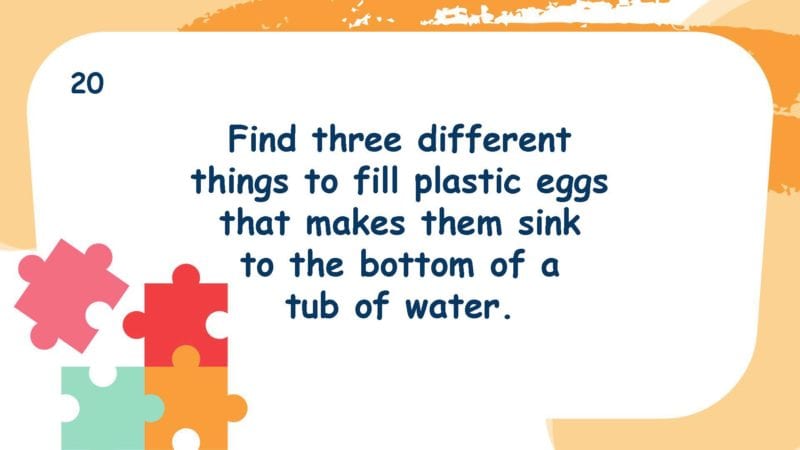
Make a snowflake from toothpicks and mini marshmallows.
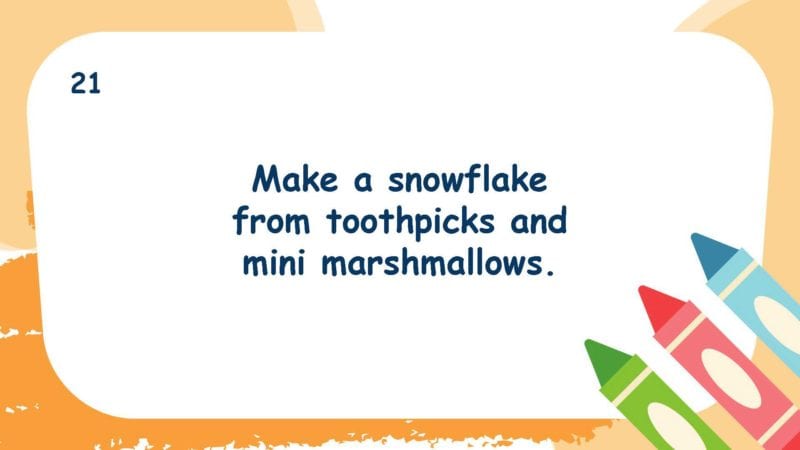
Chicka Chicka Boom Boom! Use blocks and wood craft sticks to make a coconut tree that holds as many alphabet magnets or beads as possible.
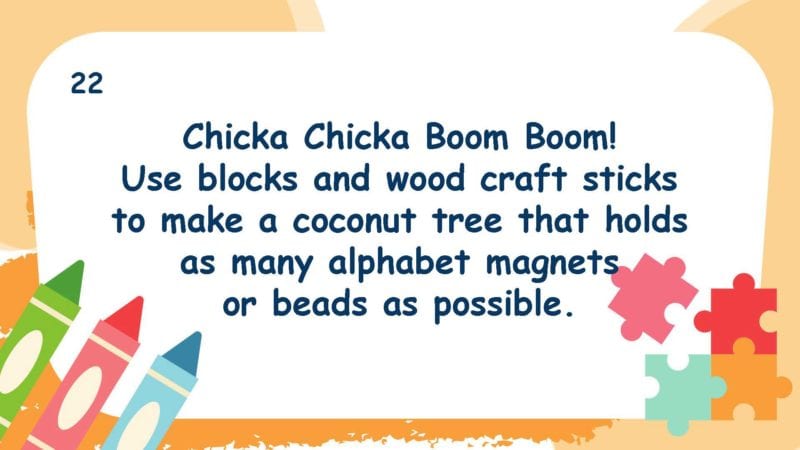
Construct a house from drinking straws and Play-Doh. You can cut the straws if you like.
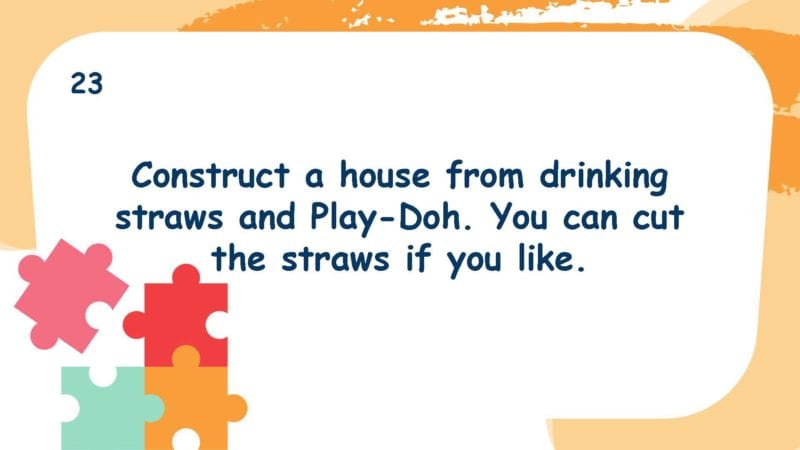
Build a fence for toy animals using wood craft sticks and Play-Doh.
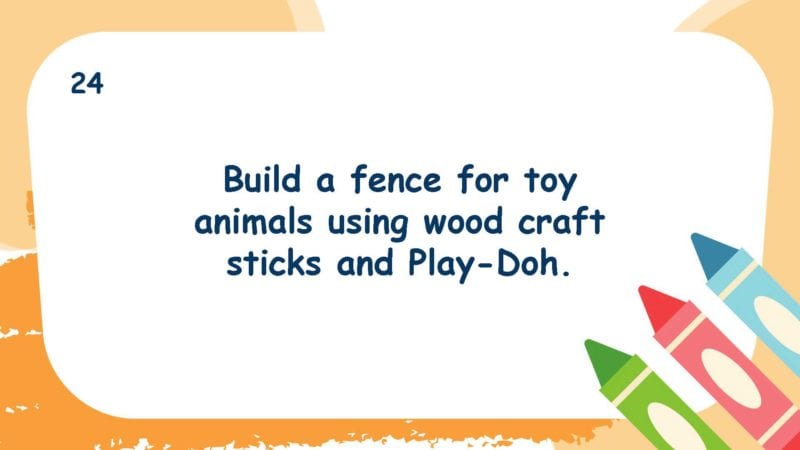
100 Day Challenge! Use 100 of something (blocks, LEGO bricks, pipe cleaners, etc.) to make a creation that celebrates your 100th day of school.
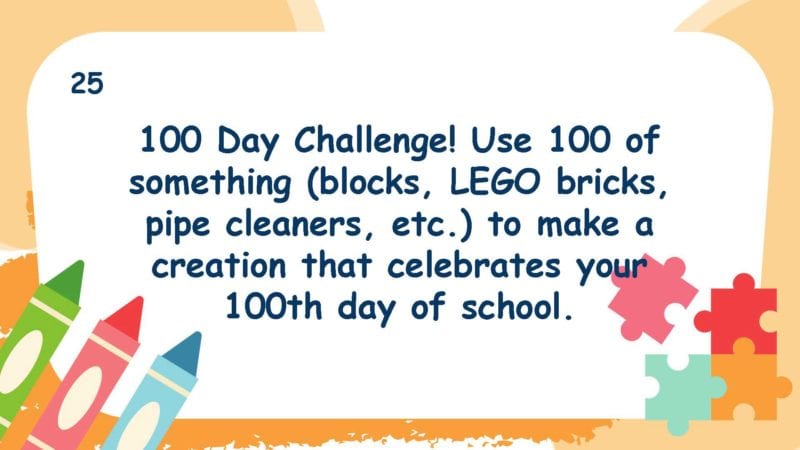
Loved these kindergarten grade STEM challenges? Check out the 23 Best Kindergarten Science Projects and Activities .
Plus, 50 easy science experiments kids can do with stuff you already have ..
Get My STEM Challenges Now!
You Might Also Like
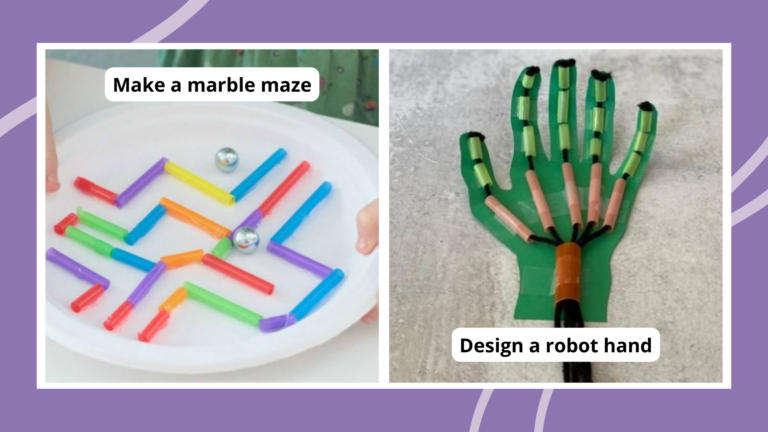
50 STEM Activities for Kids of All Ages and Interests
Inspire the innovators of tomorrow. Continue Reading
Copyright © 2024. All rights reserved. 5335 Gate Parkway, Jacksonville, FL 32256
- Member Home
- My Bookmarks

Solving Word Problems in Kindergarten
Apr 23, 2020
From real objects in the physical world , to quantitative pictures , to story mats and acting out problems , each step in the developmental journey takes our littles closer to confidence in the word problem solving process. Each step is important so that we help them arrive in the proper way instead of trying to force application of word problem skills too soon.
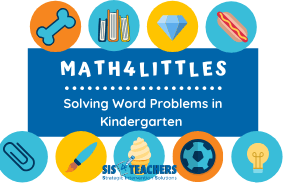
To help students take the next step of their word problem solving, we’ve created the My Math Word Problem Journal , which is developmentally appropriate for Kindergarten students at the end of the first semester or the beginning of the second semester.
Buy it now for just $5.99!
This journal contains 75 days worth of journal experiences that reinforce concrete, pictorial, and abstract means and helps students slow down through the various types of word problems. We begin with part-whole addition problems, move into subtraction, and finally missing addend problems. It helps students turn the corner in their early childhood experience to prepare them for what word problems will start to look like as they get older.
Setting the Stage
In the corner of each journal page is an image that will relate to the story problem. This helps students hold a concrete image in their head as they work with all the other abstract things (writing and number sentences) on the journal page that might not be as familiar to them. Additionally, we are still building oral language, so if students aren’t as familiar with one of the objects, they can use the story they’re reading to help them picture what might be happening.
Read the Problem
Begin by reading the problem out loud – all of it, without stopping. After this, most students will want to jump right in and fill in the number bond, or start acting it out with concrete objects. They’ll grab the two numbers in the problem and, because we’re adding this week, they’ll add them. Or subtract them, or whatever we’re working on. However, we don’t want kids to look at story problems as things to be dissected – “circle the numbers” and “underline the important words,” etc. because that really in the end isn’t always going to work for students at this age.
We really want them to slow down and engage with the problem using something called chunking. Chunking has students put a line or highlight or underline a section in the story problem that is bringing in some new information. Even though kindergarten students might not be able to read the word problem themselves, we do want them to get into the habit of “reading” the problem, interacting with the words in the story, and repeating back different parts of the problem. It slows them down enough to really comprehend and visualize what the problem is asking, just like we do in reading. The same process we use for reading a book and trying to understand the author’s message holds true for reading story problems.
Let’s take this problem:

We could chunk our example by saying, “John made a paperclip chain.” And then the students repeat that back. Now you say chunk because there’s a new piece of information within that story problem that we just read. The next part says he put on five paper clips. chunk The kids repeat that section back. He added on three more paper clips chunk . How long is John’s paper clip chain now? chunk
The hard part about doing story problems in a slow, methodical, repetitive way, even though we know it helps build kids’ skills, is that students really want a quick and easy way to solve the problem. Spending a lot of time really looking at that story problem and getting that frame of reference using our template will be really helpful to our littles in kindergarten.
Sentence Form
The second step in our step-by-step visual model process is to create a sentence form. In the kindergarten journal, we provide the sentence form since we felt that putting the question and a complete answer might be a little bit too difficult for some

In Kindergarten, it’s really important to make a note of this sentence form because, as students get into 1st grade, they’re going to start to do more closed sentences with more blanks that require students to supply names and other information. By the time a child gets to 2nd grade, they should be able to read a story problem and be able to repeat back in a complete sentence exactly the way the problem is asking.
Some people ask why we would bother putting the sentence form in a Kindergarten journal. It all goes back to wanting to really slow the students down and keep them from jumping right into numbers and operations. Having students work with the sentence form encourages good decoding and reading skills as well, and guides students in their understanding of what the problem is asking. Also, I’ve seen many students solve story problems, but then forget to write in the sentence form, so a sentence form is a really great way to help train students’ brains so that when we get that final answer, it is going into the blank, which will complete the thought.
Math Mat & Quick Draw
Whether you use our horizontal or vertical math work mat, maybe a dry erase board or a purple piece of construction paper, this step is all about concrete tools. The student can go to the Math Salad Bar and choose manipulatives they can use to act out our story problem. They might get five of something, then show three and then count them all together to show how many paper clips John had.
Eventually, students will work more in the Quick Draw Box. We’ve made this section a little bit smaller in this journal because we want students to truly make it a “quick” draw using Xs or dots or something else small to represent the quantities in the problem. In our case, the students might do five large Xs, three small Xs, and then count them all together. ’
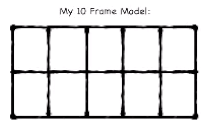
Number Bond
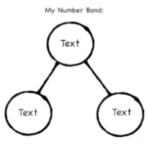
We’ve given lots of thought to each part of the journal page so far, and this algorithm should be no exception. It would be easy to just grab the numbers out of the problem and plug them into the slots and call it good. But let’s start with that first box. In our word problem, we started with the 5 large paper clips and now we need to change that number in some way, whether we add or subtract. In our example, I’m going to be counting up the chain, so I know we need to put a plus sign in the circle. I write the 3 in the other square, because I’m changing the original number by that many. The equal sign is in another box to the right, and finally there is a place to write the total.
Every journal page takes students through this entire process, so by the end of 75 days, it should be ingrained in their brains! This will help our Kindergarten littles as they head into 1st grade, where they’ll continue to build on higher levels of understanding.
Types of Problems
We have three different videos to help you to see the different types of problems that can be solved. We also use a coding system on all of our journals to help teachers understand the different types of problems that we’re using. For this journal, we have PWA (Part-Whole Addition), PWS (Part-Whole Subtraction), and PWMA (Part-Whole Missing Addend).
[yotuwp type=”playlist” id=”PL76vNL0J-a4037qQHz2DIrIBKdJs-oPYd” ]
Download the PWA Example
Download the PWS Example
Download the PWMA Example
Why do we code problems for students this young? To a parent or teacher, or even a student, It might feel like there are endless types of story problems. But in fact, we actually have families of story problems, like we have genres of books. Coding the story problems compartmentalizes these different types of story problems. If we are very clear on the type of story problems, we can help students understand the characteristics of the types of problems they will encounter so that problem solving isn’t so scary.
Part-whole problems are the first genre of story problems, and K-1 graders spend a large majority of time working in this group. However, there are lots of different types of part-whole problems – part-whole addition, part-whole subtraction, part-whole missing addend, etc. The next family of problems are the additive-comparison problems, which students will get to later in 1st grade.
In the bottom right-hand corner of each page, there is a number, up through 75. You can download the PDF, print it (or have it printed), and staple it together to make a journal for an individual student. They write their name on the front and it becomes something they work on every day, four or five days a week. Of course, we still do our number talks in the classroom, but this way we make sure we’re bringing our numbers into words and words into numbers on a daily basis as well.
It’s a really important skill for a child to be able to construct a story problem based on an algorithm or even a missing addend. Let’s take: 4 + ? = 7 If I gave a student that problem, could they think of a story that goes with that? Maybe there were 7 sheep on the farm, but only 4 of them were in the barn. How many were outside? This type of thinking really works on Math Practice 2, which is to which is reason abstractly and quantitatively, to help bring numbers and words together.
Join us next week to find out what problem solving should be looking at with a child after the Kindergarten year. We’ll be working on taking our quick draw into a proportional visual model, and then into a non-proportional visual model.
*Addition , *Subtraction , *Word Problems , Audience - Lower Elementary (K-2) , Series - Math4Littles | 0 comments
Related Posts

Screening for Numeracy Development
Dec 5, 2022
Ever feel like the years are flying by and standing still at the same time? Usually, it’s children that help us feel this odd sensation, but I also can’t believe it’s been TEN years since I first created my numeracy screeners!Ten years ago, I developed a set of...

Rekenrek Activities for Numeracy Development
Feb 28, 2022
This little-known math tool, the rekenrek, is a star when it comes to numeracy development!

Using Place Value Discs in the Math Classroom
Jan 27, 2022
I have all these place value discs - How am I supposed to use them across different areas of my mathematical instruction?? This is a question that we get from a lot of teachers and we know that having a Math Salad Bar full of tools but not knowing how to implement...

Kindergarten Lesson Plans
Dive into engaging kindergarten lesson plans for teachers, crafted by early learning experts. Find math and ELA lessons on counting, addition, subtraction, time, money, reading, writing, vocabulary, and many other essential curriculum concepts. Each lesson plan features learning objectives, fun activities, ... Read more simple instructions, and extra-practice questions. Educators trust our kindergarten lesson plans for effective teaching and seamless classroom management. Don't miss out! Start now for free!

CONTENT TYPE
- Lesson Plans
- Number Sense (11)
- Addition (28)
- Subtraction (11)
- Reading (35)
- Phonics (21)
- Books And Genres (1)
- Reading Skills (8)
- Communication Skills (5)
- Writing (3)
- Creative Writing (3)
- Grammar (4)
- Nouns And Pronouns (2)
- Prepositions And Conjunctions (1)
- Punctuation (1)
- Verbs And Tenses (1)
- Vocabulary (5)
- Making Connections In Reading (1)
Number Sense Lesson Plans

Compare Teen Numbers using Base 10 Blocks
Enhance comparison skills by comparing teen numbers with interactive base 10 block activities.

Teen Number Sequence
Practice recognizing and ordering teen numbers with engaging sequencing activities.

Counting Sequence within 20
Strengthen counting abilities with fun activities designed to practice sequences up to 20.
Addition Lesson Plans

Develop proficiency in addition by composing big numbers using small numbers on a 10-frame.


Compose Teen Numbers using Visuals
Learn to compose teen numbers using engaging visuals for a strong math foundation.

Decompose Teen Numbers using Visuals
Master decomposing teen numbers with interactive visuals to enhance number sense.

Count On from 5 on a 10-frame
Master the basics of addition using engaging 10-frame visuals to build a strong math foundation.
Subtraction Lesson Plans

Subtraction Sentences within 5
Build subtraction skills by creating and solving simple sentences with differences within 5.

Understand Subtraction
Unravel the mysteries of subtraction as you grasp this fundamental arithmetic operation!

Subtract Using Objects within 5
Bring subtraction to life by using concrete objects to model and solve subtraction problems within 5!

Subtract using Fingers
Master subtraction by learning to subtract numbers using fingers through engaging activities.
Reading Lesson Plans

Rhyme Time Rendezvous Poetry Lesson Plan
An engaging lesson plan focusing on rhymes, syllables, and poetry appreciation.

Farm Phonics Fiesta Blending Lesson Plan
An engaging phonics lesson where students blend sounds to form words.

Informational Texts Unearthed Lesson Plan
Uncover the world of informational texts and learn to support points with reasons.

Memory Magic & Animal Antics Lesson Plan
Explore memory games, animal sounds and riddles in this engaging lesson!
Writing Lesson Plans

Gratitude & Grammar Lesson Plan
Learn grammar with a twist of gratitude in this engaging lesson.

Magic of Grammar Lesson Plan
A festive journey through the world of grammar using holiday-themed activities.
Grammar Lesson Plans

Mastering Nouns and Verbs: Loko's Interactive Challenge Lesson Plan
An engaging lesson plan focusing on mastering nouns and verbs through interactive activities.

Plural Power Grammar Lesson Plan
An interactive lesson plan focused on mastering plurals.

Prepositions Unveiled: Buc-Buc's Interactive Adventure Lesson Plan
An engaging lesson plan that introduces and practices prepositions through narratives and activities.

Punctuation Parade: Loko's Capitalization Lesson Plan
Interactive lesson plan focusing on punctuation and capitalization mastery.
Vocabulary Lesson Plans

Connecting Concepts Lesson Plan
An engaging lesson plan focusing on identifying connections, solving riddles, and completing rhymes.
All Lesson Plans

Addition Sentences within 10
Strengthen addition skills by solving math sentences with sums up to 10 for a solid foundation in arithmetic.

Positional Words: Above, Below, and Next To
Enhance your spatial awareness by learning positional words like above, below, and next to.

Sort Objects by Size
Master the art of sorting and categorizing objects based on their relative sizes.

Compare Lengths
Develop a keen sense of measurement by comparing and contrasting lengths, a fundamental skill in geometry.

Missing Number in Addition and Subtraction Sentences within 5
Strengthen your understanding by identifying missing numbers in both addition and subtraction within 5.

Antonym Antics Lesson Plan
Unleash the power of antonyms through fun-filled activities and games.

Find the Missing Number in Addition Sentences within 10
Apply your understanding of addition to find missing numbers in addition sentences with sums up to 10.

Positional Words: Behind and Front
Sharpen your understanding of spatial relationships with the words behind and front.

Sort Objects by Color
Explore the vibrant world of colors as you sort and classify objects by their hues.

Measure Length Using Smaller Objects
Master the art of measuring lengths using everyday objects as unconventional units!

Add or Subtract by Counting
Learn to add or subtract by counting to build a solid foundation in basic arithmetic.

Roboko's Phonics Adventure Lesson Plan
Learn phoneme segmentation with Roboko in this engaging lesson.

Sorting & Categorizing Wonders Lesson Plan
Learn to sort and categorize with Buc-Buc's market adventure.

Compare Objects Using 10-frames
Enhance comparison skills by analyzing and contrasting objects using interactive 10-frame activities.

Use Positional Words to Complete Statements
Use positional words to accurately complete statements and develop language skills.

Sort Objects by Type
Sharpen your observational and classification abilities by sorting objects according to their types.

Measure Height Using Smaller Objects
Unlock the secrets of measuring heights with creative and engaging techniques, making learning fun and interactive.

Comprehend Addition and Subtraction
Develop a clear understanding of addition and subtraction through interactive exercises.

Lookie's Sound Quest Phoneme Lesson Plan
A fun-filled journey into the world of phonemes with Lookie's Sound Quest.

Journey into the World of Homonyms Lesson Plan
Explore the fascinating world of homonyms in this interactive lesson.

Finding One Less within 5
Learn to count one less than a given number within 5 through engaging and interactive activities.

Flat and Solid Shapes
Explore the differences between flat and solid shapes with engaging visual activities.

Compare Heights
Sharpen your observational skills by comparing and contrasting the heights of various objects!

Addition and Subtraction Word Problems
Solve real-life word problems to enhance comprehension of addition and subtraction skills.

High Frequency Words Fiesta Lesson Plan
An exciting journey into the world of high frequency words!

Teen Numbers on a 10-frame
Explore teen numbers using interactive 10-frames for a comprehensive understanding of place value.

Add using Number Bonds within 5
Strengthen addition skills by learning to create and solve simple addition sentences within 5.

Finding Two Less within 5
Practice finding two less than a given number within 5 to strengthen subtraction skills.

Flat Shapes
Explore the fascinating world of two-dimensional shapes and their unique properties!

Compare Weights
Develop an intuitive understanding of weight by comparing and contrasting various objects.

High Frequency Words Wonderland Lesson Plan
An engaging lesson plan focusing on mastering high frequency words.

Understanding Teen Numbers
Gain a clear understanding of teen numbers through engaging and interactive math activities.
Browse Our Fun Collection of Kindergarten Lesson Plans!
We are delighted to introduce our well-curated collection of kindergarten lesson plans, perfectly designed to help teachers with their math and ELA instruction.
Our kindergarten lesson plans are designed to meet the common core standards, making them a perfect resource for teachers. We believe that kindergarten kids learn and engage better in a playful environment and that’s exactly what our lesson plans are all about!
- Math Lesson Plans for Kindergarten: In kindergarten math, kids learn counting , comparing and ordering numbers , basic addition and subtraction , simple place value concepts, flat and solid shapes , comparing measurements , time , money , word problems involving addition and subtraction, and more.
- ELA Lesson Plans for Kindergarten: In kindergarten ELA, kids learn reading, phonics (blending, vowel sounds, digraphs, sight words), writing, reading comprehension (main idea, story elements, etc.), communication and speaking skills, vocabulary (synonyms, antonyms, etc.), and much more.
If you are looking for some amazing kindergarten lesson plan ideas for your class, look no further! Explore our well-curated lessons designed by our learning experts, which surpass the traditional formats and offer a completely fresh approach to kindergarten lessons.
Key Features of Our Kindergarten Lesson Plans
- Aligned with the Kindergarten Curriculum : Our lesson plans are crafted to align seamlessly with common core kindergarten standards, offering teachers essential and age-appropriate teaching resources.
- Completely Free for Teachers: Teachers and schools can easily register and access these free kindergarten lesson plans.
- Well-Defined Learning Objectives : Our lesson plans for kindergarteners feature clear and straightforward learning goals for every task, making it easy for teachers to guide the class in understanding their learning journey.
- Engaging and Interactive Learning : Each plan promotes active and hands-on learning, fostering early curiosity and a love for learning among young children.
- Effective Teaching Tips and Instruction : These plans include useful teaching methods and easy-to-follow notes for improving lesson effectiveness. Teachers can expect a comprehensive lesson overview, including the introduction, lesson development, and conclusion.
Benefits of Using Kindergarten Lesson Plans for Teachers
- Simplifies Kindergarten Instruction : Our kindergarten lessons are designed to effectively assist teachers in their instruction, making lesson preparation simpler and more streamlined.
- Organized Learning Activities : These lesson plans structure activities and teaching methods to create an effective and age-appropriate learning environment for young children. They also help in identifying learning areas that require more focus.
- Time-Focused Lessons : Each activity in our kindergarten plans includes a time estimate, helping teachers manage their classroom time effectively, resulting in impactful lessons.
- Better Engagement and Participation: These lesson plans are filled with fun and educational activities for kindergarten kids, encouraging them to participate actively in the class.
- Assessment and Evaluation: The plans provide ample opportunities that help teachers easily assess students' learning and comprehension.
What Are the Best 5 Online Kindergarten Lesson Plans?
Sharing 5 carefully selected fun kindergarten lessons to give you a better idea of the effectiveness of these lesson plans:-
- Group & Count Within 10
- Magic of Making 5 & 10
- Length Adventures: Dive into Measurement Fun
- Character Comparison Quest
- Gratitude & Grammar
Your one stop solution for all grade learning needs.
How Are You Feeling? Preschool and PreK Social Emotional Class
What's included
12 live meetings, mastery evaluation, certificate of completion, class experience, us grade preschool - pre-kindergarten, learning goals.

Introductions and Feeling Names
30 mins online live lesson, calming strategies, self regulation and calming tools, problem solving, other details, parental guidance, supply list, external resources.
Teacher expertise and credentials
Oregon teaching certificate in elementary education, live group course, financial assistance , outschool international , get the app .

More to Explore
Classes by age , classes by grade .
- Rating Count
- Price (Ascending)
- Price (Descending)
- Most Recent
Problem solving resources
Resource type.
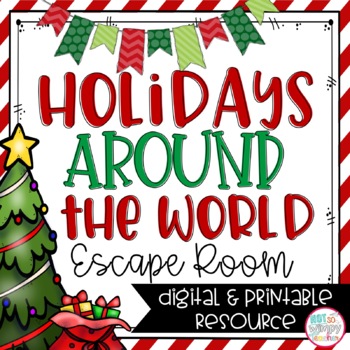
Holidays Around the World Christmas Escape Room Printable & Digital Activity

Brain Teaser Higher Level Thinking Early Finisher Summer Activities Logic Puzzle

STEM Bins® Speed Builds STEM Activities (Morning Work, Early Finishers, Centers)
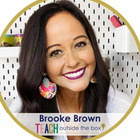
Behavior Reflection Think Sheet for Classroom Management

Classroom Calm Down Corner Kit | Identifying Feelings Emotional Regulation

Interactive ZONES of Regulation Package - Name Plates, Bookmarks, & MORE!
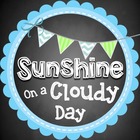
STEM Bins® Hashtag Blocks Speed Builds BUNDLE - Elementary STEM Activities
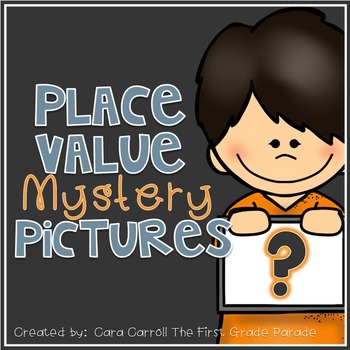
Place Value Mystery Pictures

CUBES Math Strategy Poster Display | EDITABLE

100th Day of School Activities STEM Activities

15 Working Memory Brain Games: Improve executive function in 5 minutes a day!

STEM Bins® Plastic Snowflakes / Brainflakes Speed Builds: STEM Activities SET 1
![kindergarten problem solving lesson Preview of Math Logic Puzzles: 5th grade Enrichment - [Digital & Printable PDF]](https://ecdn.teacherspayteachers.com/thumbitem/Math-Logic-Puzzles-5th-grade-Enrichment-Digital-Printable-PDF--2940959-1664738044/original-2940959-1.jpg)
Math Logic Puzzles: 5th grade Enrichment - [Digital & Printable PDF]

Classroom Procedure & Routine Visuals for Preschool, Pre-k and Kindergarten

(Educator Guide) A Little SPOT of Feelings & Emotions

Growth Mindset Escape Room Activity Game Back to School Digital & Paper

Escape Room Halloween Activity Digital or PDF Game for Parties Distance Learning
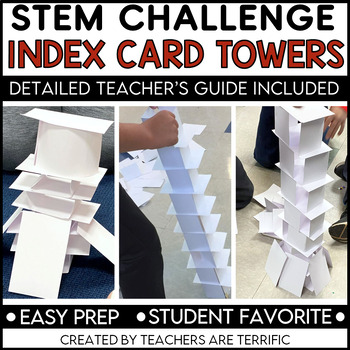
STEM Index Card Tower Challenge - Easy Prep Project- 2 Versions

STEM Bins® Hashtag Blocks Speed Builds: SET 1 - STEM Activities - Fast Finishers

Measurement Activities Project 2nd Grade, Nonstandard 1st Measuring Length Craft

Circle of Control Activities Inside vs. Outside of Our Control Lesson

Social Problem Solving Board Game for Social Emotional Learning Skills

Math Logic Puzzles: 3rd grade Enrichment - [Digital and Printable PDF]
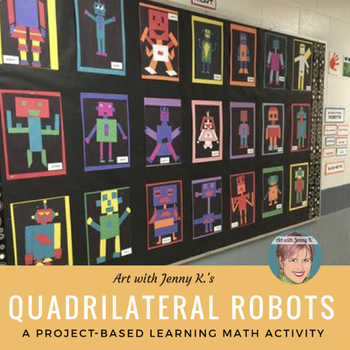
Quadrilateral Robots - Great Project Based Learning Math Activity (PBL)

- We're hiring
- Help & FAQ
- Privacy policy
- Student privacy
- Terms of service
- Tell us what you think

IMAGES
VIDEO
COMMENTS
Preschool and kindergarten problem solving activities give children an opportunity to use skills they have learned previously and give you an opening to teach new problem solving strategies. Introduce the vocabulary of solving problems with stories, puppets and everyday situations that occur. "We only have 10 apples but there are 20 students.
Teach Problem-Solving Skills With an Easy, No-Prep Activity. Explicitly teaching problem-solving skills to your students will have multiple benefits: easier classroom management, improved social-emotional learning, better self-regulation skills, and so much more. Finding the time and the resources to do it, though, can be tricky.
Lesson plans, activities and ideas for kindergarten classrooms, including math problem-solving, reading workshop, writer's workshop, inquiry-based science journals, literacy centers and more!
Free Kindergarten problem solving worksheets. FREEBIE PREWRITING WORKBOOK 10 pages ! Color & trace the pre-writing lines! This is a FREEBIE to for your students to trace pre-writing lines and color in pictures. ALL I ASK IS YOU PLEASE, PLEASE, PLEASE LEAVE FEEDBACK. This features 10 pages of drawing pre-writing type strokes.
Invite your students to complete an independent practice worksheet to show how they would solve the problem. 5. Repeat and Remind. It's an ongoing process to teach students how to be more independent thinkers and problem solvers. This process of discussing real-life situations will be ongoing in your classroom.
A fun, hands-on center or activity to do with your preschool, kindergarten or primary students. This activity addresses various critical thinking and problem solving skills. Children are also learning how to not only identify, but build basic shapes as well.This pack contains:★ "I Can" poster for center (directions for students)★ Two pages of pattern cards (8 shapes to build)★ Recording ...
Cheer on the students for solving the problem and stay close just in case they need more support. Throughout the day, try to make EVERYTHING a problem to solve. Then model, talk through your thinking out loud, and use visuals to support students as they try to solve a problem. For example, I may put out a big ball of playdough in the center of ...
7. There are 7 red chairs and 2 green chairs at the table. How many chairs are at the table all together? 8. Pete put 2 pencils in his desk. There were 3 pencils in there already. How many pencils are in Pete's desk now? 9. Tina has 4 jackets at home and 2 jackets at school.
1. A Warm-Up activity: Students learn and practice math conventions. 2. The Problem-of-the-Day: Students solve the problem individually or in groups. 3. Mathematician's Chair: Students share their solutions and give feedback to others. 4. Compare: Students compare their solutions, examining similarities and differences.
The goal of math problems is to demonstrate the day-to-day issues that require using math. Solving problems requires us to connect ordinary language and math language and includes two steps: a) modeling the problem into a math problem (or drill) and b) solving the drill using math skills. This page contains addition problems, subtraction ...
K (10) Measurement. The student directly compares the attributes of length, area, weight/mass, capacity, and/or relative temperature. The student uses comparative language to solve problems and answer questions. The student is expected to: (A) compare and order two or three concrete objects according to length (longer/shorter than, or the same).
Recording problem solving activities. Prompt students to record the results of most activities, even if they are only able to make a simple picture. Many opportunities for math problem solving will arise in a regular preschool or kindergarten day. Keep problem solving simple and age appropriate; Focus on problems that have open-ended results
Animals as Pets. Students will sort animals by identifying ones that make good pets. Browse our printable Kindergarten Logic and Problem Solving Worksheets resources for your classroom. Download free today!
Kindergarten problem solving resources. Sponsored. Spring Kindergarten Pack, No Prep, CCSS Aligned. The Teaching Treehouse. $9.00. Kindergarten Morning Tubs Bundle - Morning Work or Early Finisher Activities! Katie Roltgen. $45.00 $77.00. Interactive Math Notebook: Kindergarten.
But before you do that, here are 5 kindergarten problem solving activities for kids that will make you feel a little better about keeping them around… at least for a little bit longer. 1. Free Building Play. So after I resist the urge to whip into a crazy, toy-trashing whirlwind come across toys the kids have left out, I put them in a ...
25 Kindergarten STEM Challenges That Little Ones Will Love. They're never too young to create and explore! By Jill Staake, B.S., Secondary ELA Education. Feb 18, 2021. STEM challenges are such a fun way for kids to explore how the world works. By building and creating, they learn problem-solving skills and get hands-on experience with physics ...
Buy it now for just $5.99! This journal contains 75 days worth of journal experiences that reinforce concrete, pictorial, and abstract means and helps students slow down through the various types of word problems. We begin with part-whole addition problems, move into subtraction, and finally missing addend problems.
Day 3. Here's a chance for kids to learn about capacity and practice their estimating skills at the same time. You can use cubes, or cups of beans, or any other unit of measurement you like. Day 4. For this activity, I give the kids a variety of containers. The dollar store is a great place to get them.
Completely Free for Teachers: Teachers and schools can easily register and access these free kindergarten lesson plans. Well-Defined Learning Objectives: Our lesson plans for kindergarteners feature clear and straightforward learning goals for every task, making it easy for teachers to guide the class in understanding their learning journey.
4.9. (3k) $3.00. PDF. Problem Solving Solutions posters and techniques support your students to solve their own problems and collaborate and play with others! Problem solving is a skill we need to teach just like we need to teach letters and sounds. It takes lots of practice and visual supports.
5. Shape Sudoku. Sudoku is an interesting Japanese puzzle where the player is required to fill empty places in a grid with numbers, making sure no number is repeated in a row or column. Shape Sudoku replaces numbers with shapes, to make it more fun for kindergarteners, and is a great way to improve your little one's problem solving skills.
164 open-ended math problems perfect for whole class and small group kindergarten math warm-ups or guided math lessons. Teach problem-solving with these word problems aligned to the Australian Curriculum - Foundation stage. Each naturally differentiated math question has multiple answers to cater for a range of learning abilities.
US Grade Preschool - Pre-Kindergarten. In this class, we will practice talking about our feelings, learn feeling names and learn about calming strategies, problem-solving strategies and regulation tools and skills to use when we have BIG feelings. ... In this lesson, we will work on ways that we be a good, kind friend to others. ...
Browse problem solving resources on Teachers Pay Teachers, a marketplace trusted by millions of teachers for original educational resources. ... Natalie Lynn Kindergarten. ... These mystery pictures can be completed as an individual task OR as a whole group oral/listen & follow directions lesson. Please note. 1 st - 3 rd. Numbers, Place Value ...